Autumn 2023
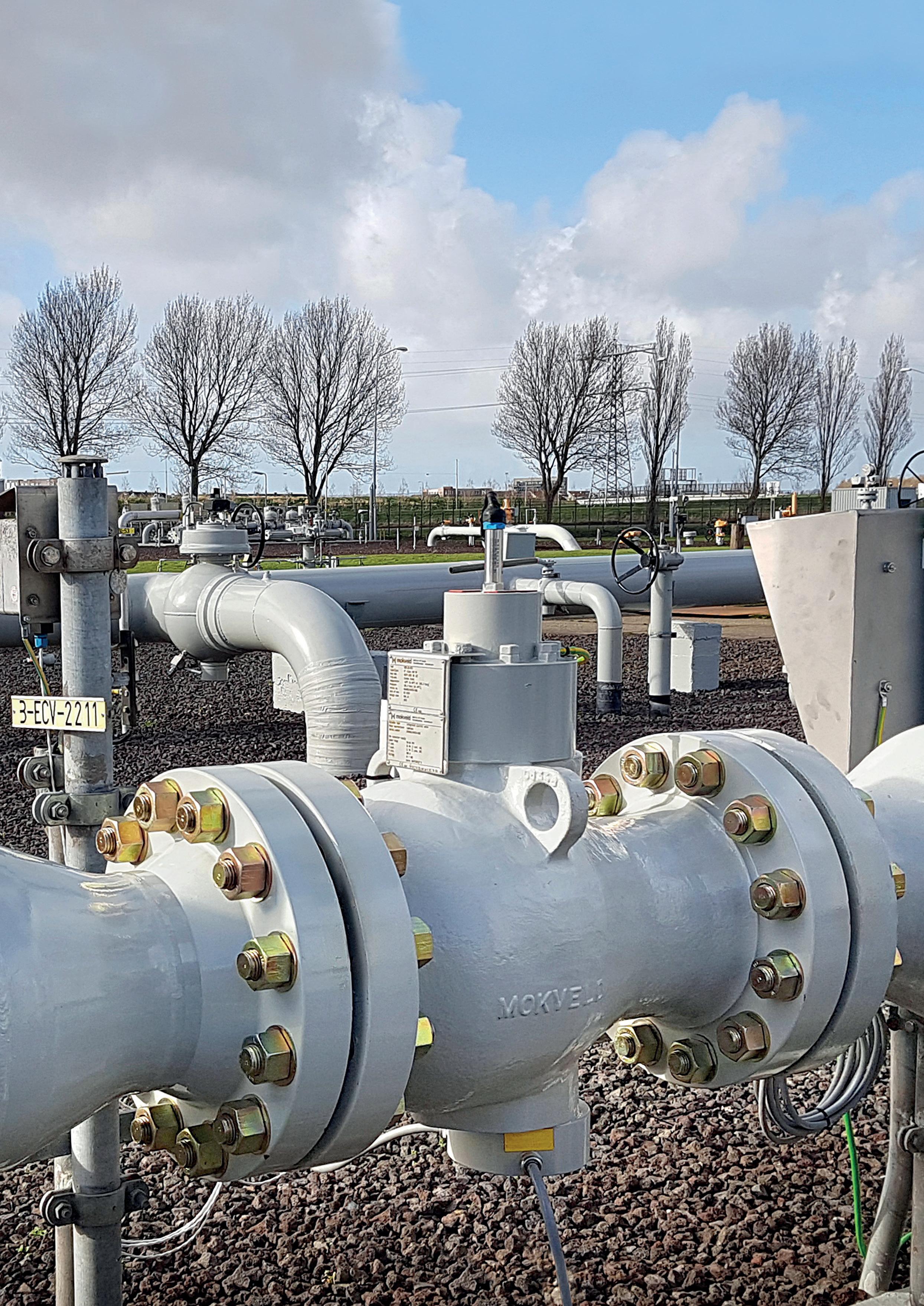
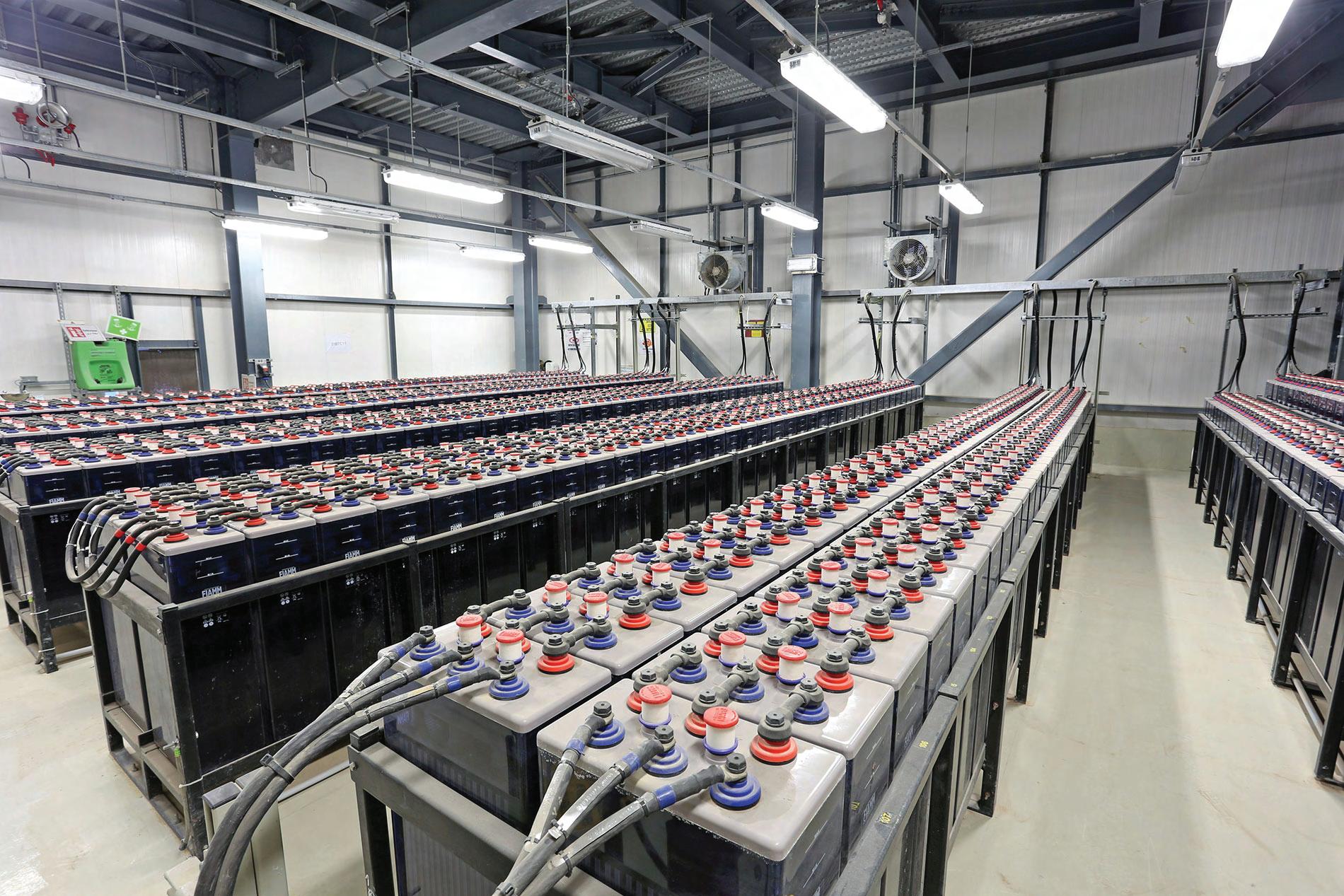

03 Comment

04 Asia: facilitating the transition
Dr Minh Khoi Le, Rystad Energy, discusses the current state of Asia’s hydrogen industry, and sheds light on how the region can implement a successful hydrogen strategy to achieve emissions reduction targets.
10 Hydrogen decarbonisation: options and considerations
As society heads toward a cleaner energy future, it is essential to build a secure and resilient hydrogen infrastructure. To do so will require taking advantage of the engineering that has been developed for hydrogen reforming processes, as well as the knowledge that exists for hydrogen use, storage and transport. Daniela Ribita, Burns & McDonnell, USA, explains.
18
Unlocking Namibia’s green hydrogen potential
Marco Raffinetti, Hyphen Hydrogen Energy, Namibia, explores how Namibia has the potential to transform Africa’s green hydrogen future.
22 Which route to go down?
Alex Brierley and Lucy Whitford, HYRO, UK, explore different ways to deliver green hydrogen to hard-to-electrify industries in the UK. 25
Keeping electrolysis cool
Evgenij Loginov and Alexander Gernhardt, Kelvion, Germany, analyse the heat exchange options that are available for electrolysis systems used in green hydrogen production.
29 Building a sustainable future for green hydrogen production
Peter Thomsen, Swagelok, Denmark, details how one Danish company is building a high-quality delivery system to make hydrogen the standard for renewable transportation fuels.
32 Compression to support decarbonisation
Marie-Laure Gelin, Howden, a Chart Industries Company, the Netherlands, explains why compression is such an important process within the hydrogen value chain.
37 Finding the key
Todd Gibbs, Atlas Copco, USA, explains why centrifugal compressors will be key to developments in the hydrogen industry.
41 High-pressure hydrogen compression
Daniel Ballorca, Hiperbaric, Spain, explains why high-pressure compressed hydrogen is the most efficient way to store energy.
46 Integrity, testing and diagnostics

Neil Gallon, ROSEN UK, and Jens Voss, ROSEN Germany, discuss the importance of pipelines in the energy transition, and the management required to ensure their safe operation with hydrogen.
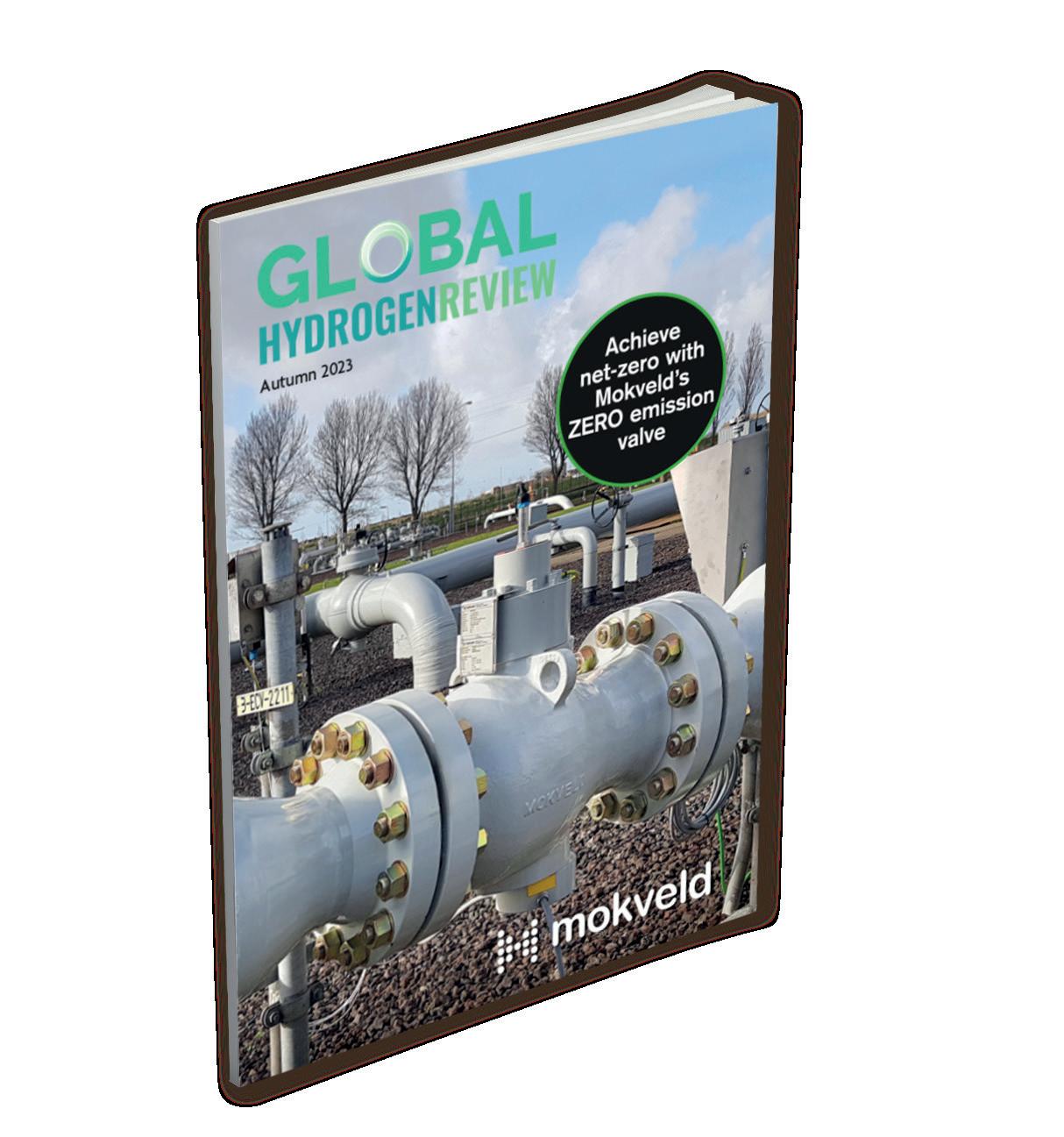
50 Fulfilling potential
Dr. Sleman Saliba, ABB Energy Industries, Germany, explores how automation technologies can help green hydrogen to fulfil its potential as a driver of decarbonisation.
54 Greener on every side
Successfully navigating the bold adventure of a new green hydrogen value chain means starting with a strategic vision of a unified automation ecosystem. Lauren Wherry, Emerson, USA, discusses how this can be achieved.
60 Accelerating production
Alessandro Piscioneri, Comau, Italy, explores how automation can accelerate the production of emission-free energy for use in mobility applications.
63 Unlocking the economy
Richard Zhang, LIFTE H2, USA, explains why digitisation is key to developing the hydrogen industry.
Achieve net-zero with Mokveld’s Zero emission valve. This Environmentally Sound Technology (EST) reduces power consumption and achieves zero fugitive emissions over the full lifetime of the valve. The internal actuator removes the need for dynamic packing seals, eliminating the main leak path of more common valve designs. ‘Wear and tear’ resulting in increasing emissions to atmosphere are history. Visit mokveld.com/zeroemission for more information.
Copyright©
@HydrogenReview like join Global Hydrogen Review @Hydrogen_Review follow
part
publication
be reproduced, stored
a retrieval system, or transmitted in any form
any means, electronic, mechanical, recording or
prior
of the copyright
All views expressed in this journal
those of the respective contributors and are not necessarily the opinions of the publisher, neither do the publishers endorse any of the claims made in the articles or the advertisements.
Palladian Publications Ltd 2023. All rights reserved. No
of this
may
in
or by
otherwise, without the
permission
owner.
are
This month's front cover
Join the conversation
Autumn 2023
MORE BUSINESS LESS CARBON NATURAL GAS, FUTURE READY.
The case for blue hydrogen is clear.
Topsoe is ready to help you scale up and bring emissions down using natural gas resources.
Take the lowest energy route to ultra-low carbon intensity hydrogen with Topsoe’s industry-leading reforming technologies and integrated carbon capture.
Find out how: topsoe.com/bluehydrogen
Managing Editor James Little james.little@palladianpublications.com
Senior Editor Callum O'Reilly callum.oreilly@palladianpublications.com
Editorial Assistant Poppy Clements poppy.clements@palladianpublications.com
Sales Director Rod Hardy rod.hardy@palladianpublications.com
Sales Manager Chris Atkin chris.atkin@palladianpublications.com

Sales Executive Sophie Birss sophie.birss@palladianpublications.com
Production Manager Kyla Waller kyla.waller@palladianpublications.com
Events Manager Louise Cameron louise.cameron@palladianpublications.com
Digital Events Coordinator Merili Jurivete merili.jurivete@palladianpublications.com
Digital Content Assistant Kristian Ilasko kristian.ilasko@palladianpublications.com
Digital Administrator Leah Jones leah.jones@palladianpublications.com
Admin Manager Laura White laura.white@palladianpublications.com
As I write this comment, the BMW PGA Championship is underway –an annual men’s professional golf tournament on the European Tour. The ‘Festival of Golf’, as it has become known, usually grabs attention as it combines world-class golf with a sprinkle of glitz and glamour. As well as live music, the event includes a Celebrity Pro-Am, where numerous stars from other sports and show business play alongside some of the biggest names in golf. There is extra press attention on the event this year, with the entire European Ryder Cup team competing in the tournament, just weeks before the start of the 44th Ryder Cup.
Global Hydrogen Review has its own reasons for reporting on this year’s Championship: it is the first ever sporting event to have its television production powered entirely by green hydrogen.
European Tour Productions, the DP World Tour’s in-house production company, and its exclusive production and distribution partner, IMG, are working with UK-based clean energy company, GeoPura, to supply two hydrogen-powered generators (HPUs) that will be positioned on the fairway of the sixth hole at Wentworth Club in Surrey, UK. The HPUs work by utilising green hydrogen to generate emission-free electricity, which is being used to power the broadcast compound. GeoPura estimates that relying on HPUs will save a total of 16.4 t of CO2 compared to the 2022 tournament.
What’s more, the golf buggies at the tournament will also be recharged using electricity generated via hydrogen for the first time.
These innovative developments form part of the DP World Tour’s ‘Green Drive’ initiative, which has seen it become the first professional golf tour to commit to being fully net zero carbon by 2040. Richard Bunn, Managing Director of European Tour Productions, has confirmed that the plan is to roll out hydrogen power across multiple tournaments in 2024. He added: “We also want to share what we have learnt with our industry peers, as tackling the climate emergency must be a collective effort.”
And this point is key: knowledge sharing is essential to the future of this burgeoning sector. This issue of Global Hydrogen Review is packed full of interesting case studies and technical articles exploring the technology and solutions that will help green (and blue) hydrogen fulfil its massive potential as a driver of decarbonisation.
Editorial/advertisement offices: Palladian Publications
15 South Street, Farnham, Surrey
GU9 7QU, UK
Tel: +44 (0) 1252 718 999 www.globalhydrogenreview.com
And in the spirit of knowledge sharing, we’d like to invite all of you to join us for the third edition of our Global Hydrogen Conference, taking place on 2 November. This free-to-attend virtual event will include insightful presentations from industry experts including Wood Mackenzie, Baker Hughes, Siemens Industry Inc. and H2scan, covering a wide array of topics such as the long-term outlook for hydrogen, the use of control valves, and how digital transformation is revolutionising the hydrogen sector. You’ll also have the opportunity to pick the brains of our expert speakers during live Q&A sessions, and network with hundreds of industry professionals. Sign up for free by clicking/scanning the QR code.
 Callum O'Reilly Senior Editor
Callum O'Reilly Senior Editor

4
Dr Minh Khoi Le, Rystad Energy, discusses the current state of Asia’s hydrogen industry, and sheds light on how the region can implement a successful hydrogen strategy to achieve emissions reduction targets.

Since 2015, a total of 30 Asian countries have published Nationally Determined Contributions (NDC), outlining the way in which they will progressively reduce greenhouse gas (GHG) emissions in accordance with the Paris Agreement in five-year periods. While more than 50% of Asian countries are now targeting net zero emissions and many of them by 2050, the reality is that the region still lags behind others when it comes to actual emission reduction commitments, with just 17 countries enshrining their NDC commitments into law. In turn, this has delayed the implementation of strategic roadmaps outlining the process for reaching emission reduction targets under the NDCs. In terms of economic prosperity, Asia is weaker than Europe and North America, with gross domestic product (GDP) per capita three times lower than in Europe, for example. Many parts of Asia are also still struggling to achieve the energy security needed to meet growing demand.
There is a limit to how much Asia can spend on supporting and incentivising new and often costly decarbonisation technologies. Clean hydrogen, which is widely accepted as a key pillar for the shift to low carbon energy, is one of these. However, whether it is blue hydrogen (fossil fuel-based hydrogen production using carbon capture and storage [CCS]) or green hydrogen (renewable energy from water electrolysis), clean hydrogen commands a premium compared to current fossil fuel-based alternatives. Asia is behind in the development of its hydrogen industry, with just four countries releasing official hydrogen strategies.
Prioritising hydrogen use
Hydrogen can be used as a decarbonisation tool in multiple sectors, from industry and power generation, to transportation and buildings. This flexibility has led to debate on where clean hydrogen use should be prioritised. Regardless, one of the imperative applications of clean hydrogen is to replace the 100 million t of fossil fuel-derived hydrogen that is currently being used in refining and chemical industries globally (mainly ammonia and methanol). Asia is the most exposed continent in this aspect, since it is the number one consumer of hydrogen at around 43 million t currently. Approximately 32% of this is being used in crude oil refineries, with the rest consumed in the form of ammonia and methanol to support fertilizer, chemical and plastics industries. With some of the largest industrial hubs in the world, countries such as India and China are consuming and producing significant amounts of ammonia and methanol. While it is possible that the demand for hydrogen in Asia’s refinery sector will reduce as transportation decarbonises through electrification, the chemical sector will need to adopt the use of cleaner hydrogen if it is to reach its climate goals. This need could propel hydrogen demand to 35 million t by 2050, compared to 29 million t presently. When it comes to producing plastics, China is the world leader and almost the only country using methanol-to-olefins to support demand at around 4 million t of hydrogen. Cleaning up the production of methanol by using clean hydrogen could provide a clear pathway for decarbonising the production of plastics. For now, Asia’s top-five hydrogen consuming countries are China, India, Indonesia, Japan and South Korea, with all but Indonesia having strategies in place to transition to using clean hydrogen.
Demand
Considering other emerging applications of hydrogen, Asia could be looking at hydrogen demand of 210 million t by 2050 if climate goals are to be met and global warming capped below 1.7˚C. The largest share of new demand will come from the steel producing sector, road transport and power generation, with a major contribution also met by demand from marine and aviation industries. China is the world’s largest steel producer, accounting for 54% of global production in 2022. India is also among the top three, producing some 6% of crude
5
steel globally. Through hydrogen, direct reduction of iron (DRI), emissions from steel production can be reduced or removed completely. Top producers such as Baowu and Tata all have indicated they will use hydrogen to decarbonise steel-making using DRI plants. One of the largest DRI plants, at 1 million tpy of DRI, is being built in Guangdong, China, by a subsidiary of Baowu Group.
When it comes to land transport applications for hydrogen, the options are passenger vehicles and heavy-duty transport segments. While electric vehicles (EVs) are emerging as the leading solution for passenger vehicles globally, fuel cell EVs (FCEV) are proving popular in Asia, especially in Japan and South Korea, with the latter dominating FCEV sales globally. South Korea is targeting 3 million FCEVs in use by 2040


compared to the 30 000 registered at present. Regarding heavy-duty transport, lengthy distances in China and India could spur the use of fuel cell trucks. Sinotruck and Weichai have recently reported combined orders for 1100 fuel cell trucks with many additional orders placed elsewhere for this class of vehicle.
Controversies and debates
The most controversial application for hydrogen planned in Asia is in power generation, with Japan announcing a target to use ammonia as a co-fired fuel in coal power plants. After successfully testing the use of ammonia as a fuel to reduce coal use, Japan now sees ammonia as a way to avoid mothballing coal-fired power plants, while also reducing emissions. JERA has issued a tender for 500 000 t of clean ammonia and has been busy establishing Memoranda of Understanding (MoU) globally with the likes of CF Industries and Yara. The plan has received a fair amount of international criticism, due to its costly nature and questionable emissions reduction potential, especially if there are no strict requirements for lifecycle emissions from ammonia, and therefore, hydrogen. Nevertheless, this has not stopped Japanese companies such as IHI and Mitsubishi from promoting the concept in Indonesia, Malaysia, Thailand and India. South Korea has similar plans for ammonia use, with China also testing the technology. With Asia’s power mix still heavily dependent on coal, clean ammonia could help many countries wean themselves off the fuel. Japan may also be looking to begin with ammonia as it works to become Asia’s leader in the global hydrogen economy.
6 Autumn 2023 GlobalHydrogenReview.com
Figure 1. Map showing NDC and hydrogen strategies in Asian countries (source: Rystad Energy climate policy solution).
Figure 2. Hydrogen consumption in Asia towards 1.7 ˚C scenario by sector and country (source: Rystad Energy HydrogenCube).
ACCELERATING BLUE HYDROGEN TOGETHER
The world’s energy systems are changing; and hydrogen is becoming a key part of the future energy mix. With that need for very large volumes of hydrogen on the horizon, Shell Catalysts & Technologies has developed a low cost, high capacity way to match those production needs via the Shell Blue Hydrogen Process. The processes bring together several proven technologies to deliver 500 te/day of hydrogen with >95% CO2 capture rate at the lowest levelized cost. It’s a hydrogen solution designed to help decarbonize hard to abate industries, lower the CO2 footprint of heavy transport, and reduce home heating emissions.
Learn more at http://catalysts.shell.com/bluehydrogen
Despite the drawbacks, governmental and corporate commitments on using ammonia is one of the ways to incentivise the development of a hydrogen sector, especially on the supply side. Based on all projects globally that have been announced or have reached a certain level of maturity, Asia presently has just 11 million t of clean hydrogen projects in the pipeline by 2050. That is a far cry from the 210 million t required under Rystad Energy’s 1.7˚C scenario and a quarter of current grey hydrogen consumption in the region. India has the largest share of this supply pipeline and is neck-and-neck with China. India has had somewhat of a head start with the government committing to a target of producing 5 million t of green hydrogen by 2030. China, which is still suffering from fallout from the pandemic, has had a slower start. Rystad Energy expects that both of these countries will add considerably more capacity to their project pipelines, as demonstrated by the construction this year of the world’s largest electrolyser plant in China, the 250 MW Kuqa facility. Central Asia also features in the current project pipeline, thanks to efforts underway in Kazakhstan and Azerbaijan. With good renewables resources and good land availability, projects in these nations involve giga-sized electrolyser developments proposed by foreign entities such as Fortescue Futures Industries, ACWA Power, Masdar and Svevind, with the latter’s 26 GW hydrogen project in Kazakhstan the largest in Central Asia, and in Asia as a whole. Mirroring the global trend, green hydrogen dominates the outlook for clean hydrogen production in Asia, accounting for 81.8% of the project pipeline by 2050. The remainder comprises mostly blue hydrogen, though pink hydrogen from nuclear power also features, with Indonesia and South Korea leading in this respect. With South Korea considering building more nuclear power generation capacity, green hydrogen could be produced from this zero-carbon power source as well as conventional renewable energy.
Fulfilling potential
Considering the potential for renewable energy growth, China and India could likely meet much of their own hydrogen needs for decarbonisation. In other Asian countries, the situation is a little different. Japan and South Korea, which both have limited capability to build out renewables at the required pace, will look to be net importers of hydrogen, just as they are for other fossil fuels. Southeast Asian countries are likely to emerge as a mix of importers and exporters. Singapore will be a hydrogen importer due to its demand for power and bunkering for marine fuels, with Thailand and Indonesia also likely to become importers. In this respect, many Asian nations will need to look outwards for inexpensive green hydrogen sources, hence why MoUs are being signed with Australia and Africa (Namibia) to name a few.

Regardless, governments in Asia must reconcile their need for clean hydrogen with its expense at a time when energy security remains a pressing issue. Efforts and incentives to close the future hydrogen supply and demand gap are emerging. A green hydrogen tender by Solar Energy Corp. of India (SECI) has been issued, with the Singapore government calling for expressions of interest for hydrogen-powered generation and bunkering solutions. Japan proposed a contract-for-difference (CfD) incentive mechanism in its recently updated hydrogen strategies. Mirroring their supermajor counterparts, state-owned national oil companies such as Sinopec, Petronas, PTT and Pertamina, have also started to invest in hydrogen projects in the region.
One thing that Asia can bank on for hydrogen is its expertise in creating supply chains. The ability to scale up quickly and provide cost-competitive options compared to Western counterparts will continue to play a key role here, just as it has in the solar industry. China has been one of the largest producers of alkaline electrolysers for some time, with solar giants such as Longi and Sungrow now entering the global market. Multiple manufacturing plans have also been pushed in India, many of them backed by industrial giants such as Adani, Reliance or Larsen and Toubro, as the nation looks to compete with China from the concept stage, learning lessons from developing a solar supply chain. In China, major initial government incentives such as feed-in-tariffs have been used to create a successful domestic solar industry, an approach also likely to be used in developing a hydrogen industry.
8 Autumn 2023 GlobalHydrogenReview.com
Figure 3. Clean hydrogen production in Asia by country and type by 2050 (source: Rystad Energy HydrogenCube).
Invisible. Invaluable.
You can’t see hydrogen, a zero-carbon fuel that perfectly complements— and even accelerates–the integration of renewable energy sources for ammonia producers. But the impact of this essential element creates an invaluable path forward towards decarbonization, supporting expansion and energy transition for multiple energy consumers, including maritime, industrial, and power generation facilities.

Black & Veatch delivers on:
• Safe, reliable, and informed innovation across the hydrogen value chain

• Solutions across green hydrogen for power generation and storage, as well as the processing of blue hydrogen with carbon capture technology
• Diversity of experience and depth of knowledge, offering practical insight and access to the right resources at the right time
Let’s find ways to help you.
As society heads toward a cleaner energy future, it is essential to build a secure and resilient hydrogen infrastructure. To do so will require taking advantage of the engineering that has been developed for hydrogen reforming processes, as well as the knowledge that exists for hydrogen use, storage and transport.
Daniela Ribita, Burns & McDonnell, USA, explains.

10
Throughout the 20th century, hydrogen production has been used at sites for refining; fertilizer production; glass purification; ammonia and biofuels; fuel cells; and rocket fuel. Low-carbon hydrogen production will play an important role in the future energy market, due to its high energy density and clean burning fuel properties. Sustainable and low-carbon hydrogen production will likely satisfy versatile markets across the sectors of shipping, transport, heavy industries, chemicals, and sustainable aviation fuel (SAF), according to the US Department of Energy (DOE)’s National Clean Hydrogen Road Map, released in June 2023.¹ The challenges that come with large-scale hydrogen production, storage and distribution can be overcome to create a safe and resilient hydrogen market that plays an important role in advancing the future of energy.
There are four hydrogen synthesis pathways: reforming, electrolysis, gasification and pyrolysis. All methods are critical for reaching long-term hydrogen production goals, and offer opportunities for efficient and sustainable processes, such as biomass gasification and solar- wind- and nuclear-powered electrolysis. This article will focus on the opportunities and challenges that come along with using the most common hydrogen production method: reforming.
For existing reforming production sites, installing carbon capture, utilisation and storage (CCUS) is the leading market decarbonisation solution. The firms that are exploring greenfield hydrogen reforming sites have a considerable set of parameters to balance for a successful economic and environmental model, such as: hydrogen production plant design (including utilities, power and plot space), CCUS, hydrogen end users, delivery form (gaseous vs liquid), geographical location, and overall life cycle analysis (LCA).
The two main reforming methods are steam methane reforming (SMR) and autothermal reforming (ATR). Both use hydrocarbon gas and produce syngas that is rich in hydrogen and carbon monoxide (CO), with carbon dioxide (CO2) as a byproduct. The typical source of hydrocarbon gas is methane-rich natural gas and/or biogas. The reforming process converts at least 80% of methane to hydrogen.
The produced syngas is processed to purify hydrogen, typically via pressure swing adsorption (PSA), to levels that meet downstream sector needs – as high as 99.999%. Purified gaseous hydrogen user pathways

11
sometimes include manufacturing new products at hydrogen production sites. Certain hydrogen-based products, such as ammonia and methanol, can be used as liquid organic hydrogen carriers (LOHC) for transport via existing pipeline infrastructures. The use of LOHCs is being explored as a solution to overcome the challenges of large-scale hydrogen storage and transportation, such as leaks, steel embrittlement and initial CAPEX for new pipelines.
Pure hydrogen storage and transportation options for offsite use are contingent on gaseous hydrogen or liquid hydrogen. Once purified, the hydrogen can be kept in a gaseous form and compressed to high pressures of 750 – 1000 barg for specialised tube storage and transport, or liquefied to -420°F via two-stage cold box technology for specialised truck tanker transport. The gaseous hydrogen storage and transport for large-scale production is cost prohibitive because of the small volume of storage and transport hydrogen tubes. Liquid hydrogen provides more storage capacity and transport per unit of volume, although the large-scale liquefying methods are more energy-intensive and still developing.
Storage and transport costs along with greenhouse gas (GHG) cradle-to-grave impact are important parameters to consider when selecting the hydrogen production site. Proximity to end user opportunities should be thoroughly considered. For example, as hydrogen fuel stations grow beyond the market in California, US, companies may benefit from more location flexibility. The National Renewable Energy Laboratory has developed a projected hydrogen fuelling stations US map.²
In addition to pure hydrogen processing, transport and end user options, key economic and GHG opportunities exist within the hydrogen reforming process. To better understand reforming decarbonisation, the next section of this article will look at the chemistry of SMR and ATR.

SMR
In an SMR, natural gas is mixed with steam to produce hydrogen via two main reactions. First, the hydrocarbons are converted to syngas of mainly hydrogen and CO via the following endothermic SMR reaction:
CH4+ H2O ⇄ CO + 3H2 [ΔH˚ rxn = 206 kJ/mol] (1)
The secondary slightly exothermic reaction, water gas shift (WGS), promotes additional hydrogen production by combining the CO in syngas with more steam. CO2 is a byproduct of this reaction:
CO + H2O ⇄ H2 + CO2 [ΔH˚ rxn = -41 kJ/mol] (2)
Both equations’ equilibrium is favoured under excess steam, which is typically fed in a steam-to-carbon molar ratio of 2.5:1 – 3:1. Heat integration is a key economic process variable that can be controlled by minimising steam/condensate export requirements. Any unintegrated produced high-pressure saturated steam could be used within other facility units or exported offsite.
Overall, hydrogen production via SMR is highly endothermic and a large amount of heat is required to keep the reaction at a constant optimal temperature of about 800°C. The energy is supplied via natural gas and PSA tail gas to fire the reformer burners. While the flue gas from firing is released to the atmosphere, environmental regulations dictate allowable NO x levels due to its potency as a GHG (298 CO 2 e) and its role as a smog precursor. Low-NO x burners, coupled with ammonia or urea-based selective catalyst recovery (SCR), are systems used to mitigate NO x emissions.
ATR
The ATR converts natural gas into hydrogen-rich syngas via three reactions, two of which are the same as SMR. After the contaminants in the natural gas stream are removed similarly to SMR, the feed gas is mixed with oxygen and partially oxidised via an exothermic reaction:
CH4 + 1/2O2 ⇄ CO + 2H2 [ΔH˚ rxn = -36 kJ/mol] (3)
The partial oxidation reaction heat is used to drive the reformer reaction. Unlike the SMR, no natural gas/fuel gas is required in the ATR to support the endothermic reformer reaction because the heat generation reaction occurs in tandem with the reforming reaction. Fuel gas may be required in the fired heater upstream of the ATR for pre-reforming, but in smaller amounts compared to SMR reformer requirements. The oxygen source for the partial
12 Autumn 2023 GlobalHydrogenReview.com
Figure 1. Reforming hydrogen production options and potential pathways for transportation.
Go Hydrogen.
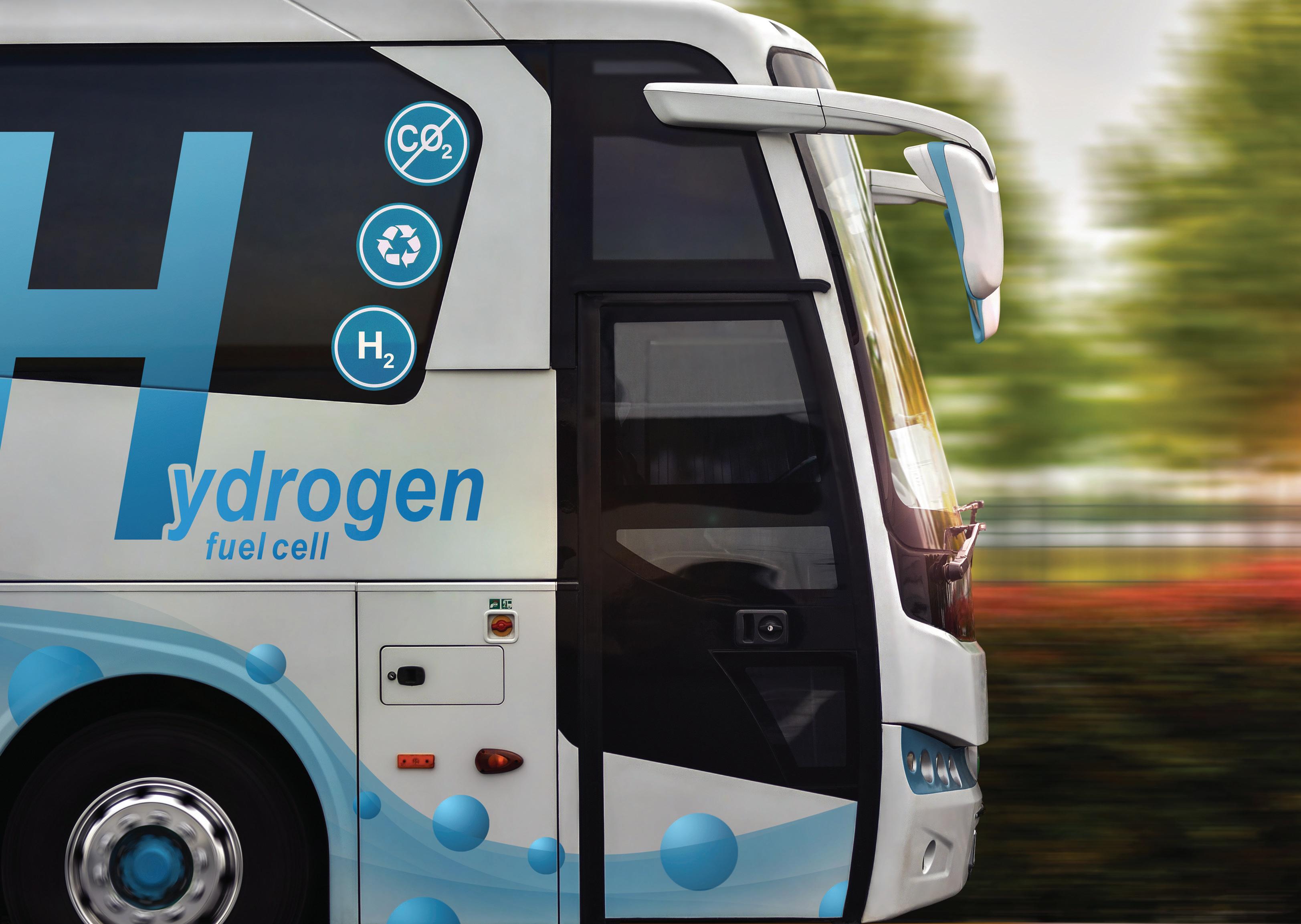
Emerson’s precision, high-pressure Coriolis dispensing solutions reduce safety concerns without compromising capacity. Harness the power of alternative fuels to drive efficiency as you take your business to new distances.
Learn more at www.emerson.com/micromotionhighpressure
oxidation reaction can be an over-the-fence supply or from a dedicated air separation unit (ASU) onsite. Oxygen delivery could pose a significant economic and power impact on overall hydrogen production.
ATR efficiency and reaction equilibrium is highly dependent on the following two ratios: oxygen-to-carbon (typical = 0.6:1) and steam-to-carbon (typical = 0.5:1.5).
SMR and ATR comparison parameters
The economic and energy equilibrium between the SMR and ATR methods are intertwined and prone to discussion as companies attempt to balance out the benefits. The following section will discuss the main parameters of interest that can tip the scale. Typical comparison parameters are presented in Table 1.
There is general excitement about the ATR method due to the exothermic reaction heat that aids in the overall reforming process and mitigates CO 2 emissions related to atmospheric combustion. The ATR reaction requires less excess steam yet needs oxygen to run the exothermic reaction. Overall, the ATR method is expected to require approximately 10% less natural gas feed compared to SMR, thus assuming the potential of higher SMR operating costs.
On the other hand, the operation of an ASU incurs additional power and utility consumption and a potential waste of unused nitrogen byproduct. A theoretic economic break point is being explored in the industry where the ASU additional utility, power and economic incurrence no longer has a significant impact, when compared to the SMR technology. Ultimately, each facility will need to investigate options specific to the site, as particular production scale and site variables, including end user options, are typically in play to decide the production method for a specific project.
Carbon capture and its sequestration or use options are key considerations when looking at long-term sustainability goals as well as specific project goals for blue hydrogen. These considerations could also tip the scales when selecting the reforming technology, especially from a GHG perspective.
Blue hydrogen carbon capture
In blue hydrogen production, both the SMR and ATR are engineered to accommodate a carbon capture unit to meet net zero goals and reach carbon intensity (CI) scores that can reap the benefits of the carbon tax incentives provided under section 45Q of the 2022 Inflation Reduction Act (IRA). The typical carbon capture method in reforming is pre-combustion, downstream of the WGS reaction. Pre-combustion is expected to have a CO 2 recovery rate of 95% for ATR and about 60% for SMR.
Consideration to post-combustion methods could be given in an SMR plant where additional carbon can be captured off the reformer burner flue gas; however, this additional process will impact the economics/CI balance.
Pre-combustion carbon capture at a plant is expected to be performed via an adsorption or cryogenic unit. The carbon capture technology selection has another subset of parameters that can impact the plant’s economics. One such parameter is the use of either water or air cooling. The selection would result in either more utility water demands or higher initial capital costs, in the case of air coolers. The decision would be unique to site location (cold vs warmer climates, and proximity to existing utility infrastructure).
CO
sequestration or utilisation
2
CCUS is a complex subject that should be evaluated as part of the reforming-based hydrogen synthesis for technical, geological and regulatory considerations. The tax credit incentive under the IRA varies based on the carbon capture method and how the captured carbon is further processed: sequestration, or third party use. When selecting a new site, there could be benefits for locating within proximity of a facility that can use the CO 2 , such as a bottling or frozen food company, fertilizer plant, plastics synthesis site, CO 2 cement fixing, or methanol manufacturing facility.
If proximity to a CO 2 user is not an option, then the project owner needs to consider geologic or biologic sequestration. Biologic sequestration, such as offsetting, is a partial solution that many companies use to balance atmospheric CO 2 emissions. Underground geologic sequestration is the typical selected method that can handle large quantities of CO 2 and there are ongoing geological studies worldwide designed to analyse a multitude of potential deep sequestration locations.
Conclusion
It is an exciting time to be in the oil, gas and chemical industry as new and evolving technologies, processes and uses for hydrogen take shape on the way to a cleaner energy future. Entities interested in embarking on hydrogen and CCUS projects will face many challenges, but will find the process less frustrating and more efficient when working with knowledgeable partners who can help to successfully handle such multifaceted ventures.
1. https://www.hydrogen.energy.gov/pdfs/us-national-cleanhydrogen-strategy-roadmap.pdf
2. https://www.nrel.gov/gis/assets/images/map_hydrogen_fueling_ stations.jpg
14 Autumn 2023 GlobalHydrogenReview.com
References
Property SMR ATR Reaction type Endothermic Exothermic Steam to carbon molar ratio 2.5:1 – 3:1 0.5:1 – 1.5:1 Oxygen to carbon molar ratio N/A 0.6:1 – 1.0:1 Heat integration Capable Capable Natural gas feed Base 10% less ASU N/A Additional CAPEX (plot, equipment)/ OPEX (power, utilities) Carbon capture 60% without post-combustion capture 95%
Table 1. SMR/ATR comparison parameters
We understand how you need to reduce complexities at your plant.
CLEAN PROCESS + CLEAR PROGRESS
You strengthen your plant’s safety, productivity and availability with innovations and resources.

Endress+Hauser helps you to improve your processes:
• With the largest portfolio of safety instruments that comply with international regulations
• With applied technologies and people who have extensive industry application know-how
• With access to accurate and traceable information
Do you want to learn more?
www.endress.com/oil-gas
Protective Coating Solutions for the Emerging Hydrogen Economy
While the properties of hydrocarbons are well understood, and have a long history of industrial use, the hydrogen economy is still in its infancy. Reliable design and directoperational experience are still limited, so new standards and proven technologies that can address these unique hazards are required.

PPG’s global capabilities and respected protective coating range enable us to provide coating solutions for the clean energy segment. We offer a complete coating portfolio for corrosion protection, chemical resistance, and passive fire protections (PFP) for hydrocarbon and hydrogen (H2) facilities.
For H2 facilities utilizing steam methane reformer (SMR) process units, PPG coating solutions address H2 environments with a full product offering, including globally recognized brands such as PPG SIGMAZINC™, PPG SIGMAFAST™, PPG SIGMADUR™, PPG NOVAGUARD™, PPG HI-TEMP™ and PPG PITT-CHAR™. Please contact your PPG representative for guidance and product selection.
Since its introduction in 2019, the PPG PITT-CHAR NX coating has established itself as a leading passive fire protective (PFP) coating for many major LNG projects. Commonly referred to as the transition energy source, LNG is expected to remain as the primary low carbon hydrocarbon source and economically preferred option when combined with carbon capture systems.
As with hydrocarbon fuels, there is potential for jet fires to occur in H2 facilities, which will require the protection of critical structures and equipment using PFP coatings. H2 fires are expected to burn hotter and, due to the higher volumetric outflow, can burn much faster than most hydrocarbons currently in use.
To further strengthen PPG’s position as a coating solution leader, PPG identified the need to generate baseline performance in H2 fire environments using its PPG PITTCHAR NX PFP coating. The data will improve the industry’s understanding of H2 fire impact on PFP with the common goal of improving H2 fire safety standards, which will provide safety engineers with a reference point for future specifications.
A H2 fire hazard differs depending on the form in which it is being handled, with the most common forms being cryogenic liquid, cryo-compressed (CcH2), Hydrogen/ Natural Gas blends (typically up to 25% H2) and very highpressure storage in cylinders at pressures of 350 to 700 bar (5,000 to 10,000 psi) with the latter being preferred for a range of applications from fuel-cell vehicles to power for data centers.
The fires from leaks at very high pressure are of particular interest as they may be extremely erosive and little, or no, research had been carried out on their effects on PFP material.
PPG
Hydrogen (H2) is one of a few low carbon energy sources recognized as reaching established net-zero goals. Consequently, it continues to attract strong interest. Even if partially realized, the hydrogen economy equates to a greater number of hydrogen production and handling facilities.
PPG commissioned a third-party test facility to undertake hydrogen jet fire testing using their High-Pressure Hydrogen Release (HPHR) facility.
The hydrogen jet fire tests performed were intended to replicate the thermal and erosive effects from a leakage at very high pressure that could impinge on adjacent tanks or structures. Four tests were successfully completed with pressure and temperature data, video, photographs, and infra-red camera imagery to document and reinforce the resulting data.
Two tests were carried out on bare steel plates (similar to the material used in the ISO 22899-1 jet fire test standard). These tests showed that, although the hydrogen fires were relatively short in duration (depressurizing in approximately five minutes), the steel reached critical core temperatures of 400°C in less than one minute, less than half the time of the standard jet fire test, thereby risking failure of impinged tanks or structures before safe distances could be established or active fire protection solutions enabled.
Two further tests were conducted where the PPG PITTCHAR NX coating had been applied to the steel specimen. These tests demonstrated that the protective coating was quick to react to the heat of the hydrogen flame and was capable of resisting the highly erosive high-pressure jet, thus maintaining the steel temperature to below 100°C (212°F) for the full duration of the release.

PPG coating solutions are leading the industry when it comes to testing hydrogen PFP coating systems and focusing on the safety of the facility and its personnel. Contact your local PPG representative for further information.

For more information, visit www.ppgpmc.com or contact:
Asia Pacific
+86-21-6025-2688 ppgpmc.ap@ppg.com
Europe, Middle East and Africa
+32-3-3606-311 customers@ppg.com
Latin America
+57-1-8764242 ext. 201 ppgpmcandean-ca@ppg.com
North America (US & Canada)
+1-888-9PPGPMC PMCMarketing@ppg.com
The test results show that the PPG PITT-CHAR NX coating performs to the highest standard in a high-pressure hydrogen jet fire environment, effectively reducing the heat transfer to the substrate.
TEST DFT mm ∆ T°C Range °C Max Temp 1 Uncoated 976 988 2 6.6 mm 63 60 – 83 83 3 Uncoated 1031 1059
PPG PITT-CHAR NX coating resisting high erosive forces
The PPG logo, We protect and beautify the world, and all other PPG marks are property of the PPG group of companies. All other third-party marks are property of their respective owners. © 2023 PPG Industries, all rights reserved.

18
To some, Namibia may not be the first country that springs to mind when thinking about the gateway to Southern Africa’s green hydrogen future. The 35th largest country in the world by landmass and the second least populated, Namibia holds large swathes of sparse, coastal desert – but it is these exact characteristics that make it the optimal location to become one of the world’s lowest cost green hydrogen producers.
The country is quickly realising its role as the key to unlocking an entire continent’s green hydrogen potential and achieving global decarbonisation goals. In partnership with the Government of Namibia (GRN), Hyphen Energy is planning to build Sub-Saharan Africa’s largest, and its only fully vertically integrated, green hydrogen project.
Blueprint for Namibia and beyond
Namibia has huge ambitions to scale up its green hydrogen production to 10 – 15 million tpy, making it one of the largest producers of green hydrogen globally. Hyphen’s project will help the country to achieve this.
A crucial element of this scale up is that all the high renewable resource land is owned by the GRN, allowing Namibia to plan for green hydrogen production volumes that are 50 times more than that produced by Hyphen, sufficient to sustain as many as 200 000 direct jobs annually.
To put this into perspective, the world needs to produce approximately 550 million – 660 million tpy of green hydrogen if global 2050 decarbonisation targets are to be met successfully. This equates to around 3000 Hyphen-sized projects just to meet the hydrogen energy mix for 2050 ambitions.
Namibia can provide the blueprint for sustainable, inclusive development of natural resources that the rest of Africa and indeed the world can follow.
Untapped potential
Green hydrogen only requires four ingredients: sun, wind, land, and water. This means that it can technically be produced anywhere in the world. However, when it comes to the first three of these key resources, Namibia has a competitive advantage.
Namibia is a vast country, with a population of only 2.5 million that predominately live in urban areas, meaning it has large tracks of uninhabited and undeveloped land with some of the highest onshore wind and solar resources in the world – in other words: huge, untapped potential.
Namibia’s ambitions are underpinned by a clear vision to position itself as a global player in the green hydrogen sector. The nation is leading the world in the development of government policy and supporting legislation to unlock the sector, enabling green hydrogen production to rapidly scale up.
World class project
Hyphen’s project will be located within the Tsau ||Khaeb National Park in the Namibian Desert.

Representing an investment of over US$10 billion, roughly equivalent to the country’s annual GDP, the project will consist of wind and solar renewable energy facilities that will power an electrolyser to produce hydrogen. This will then be converted into green ammonia for export.
The project will produce 2 million tpy of green ammonia for regional and global markets, from approximately 7 GW of renewable generation
19
Marco Raffinetti, Hyphen Hydrogen Energy, Namibia, explores how Namibia has the potential to transform Africa’s green hydrogen future.
capacity and approximately 3 GW of electrolyser capacity. This 7 GW of generation capacity is approximately nine times that of Namibia’s capacity and will cut 5 � 6 million tpy of global CO2 emissions. That is more than Namibia’s total emissions in 2021 (4.01 million t) and is approximately equivalent to the emissions created from powering one million houses for a year.
The Hyphen project will convert renewable energy to ammonia, which can then be carried and shipped long distances, to the global demand centres of Europe, South Korea, and Japan to help with the decarbonisation of their heavy industry.

Alongside decarbonising global industries, the excess electricity generated by wind and solar power will be provided to Namibia’s national grid, helping the country meet its own clean energy ambitions and act as a catalyst for energy independence while assisting in the decarbonisation of the wider Sub-Saharan African region.
A first of its kind agreement
Working closely with the GRN means that this project is structured in a way that is equitable, sustainable, environmentally responsible and socially just.
On 20 June 2023, the GRN announced that it was exercising the option afforded to it by Hyphen to take up a 24% shareholding in the company, making GRN, and the people of Namibia, a direct equity partner in the project. Nowhere else in the world has a project been structured in such an inclusive and sustainable manner. From an investor perspective, Namibia is one of the lowest risk countries in Africa, which enables a highly favourable investment environment, further underpinned by strong democratic principles, meaning that international project developers can plan for the long-term and attract financial partners.
Hyphen, in partnership with the GRN, has an enormous responsibility as Namibia’s first GW scale project, to establish the framework and architecture for the creation of an entire industry.
Impact on Namibia and beyond
At the heart of the project is Hyphen’s commitment to the socio-economic development of Namibia, through job creation and local procurement. This new industry at full scale could support around 200 000 direct jobs, with many more indirect roles being created in various sectors – from construction to retail.
Hyphen estimates that the project will create 15 000 new jobs during the construction phase and 3000 permanent jobs at full capacity. The target is for 90% of these jobs to be filled by Namibians. Hyphen is also targeting 30% local procurement of goods, services and materials during the construction and operational phases.

Hyphen launched its Socio-Economic Development Framework on 24 July 2023, setting out these targets that represent the company’s good faith estimates for employment and local procurement, which will be verified through baseline studies. These will provide GRN with the data needed to determine what levels of localised employment and procurement are actually feasible.
As well as job creation, the project will generate significant income to the Namibian fiscus through the payment of land rentals, royalties, and taxes. GRN has indicated that the increased revenues from the project are estimated at 20% of GRN’s annual fiscal collections. There are also all of the associated benefits that come with the project – improved infrastructure such as utilities, with electricity and potable water to the towns of Aus and Lüderitz, and educational opportunities through training and upskilling programmes.

What next?
GRN is driving the strategy for the creation of an entirely new industry in Namibia, with Hyphen being the lighthouse project from which it will be scaled. To realise these goals, the focus now shifts to the delivery of the project, with the GRN responsible for the development of the necessary legislative environment required to launch the industry. Meanwhile, Hyphen will focus on the final design and commercial contracting required to build, finance, and operate a project of this scale.
Creating a new industry of the scale envisioned by the GRN is never going to be an easy task. But working under the visionary leadership of the GRN, Hyphen is excited for what lies ahead and the company is ready to play its role as the foundation project on which Namibia’s green future will be built.
20 Autumn 2023 GlobalHydrogenReview.com
Figure 1. Projected images of Hyphen’s green hydrogen plant.
Figure 2. Pipelines will transport liquid green ammonia to ships.
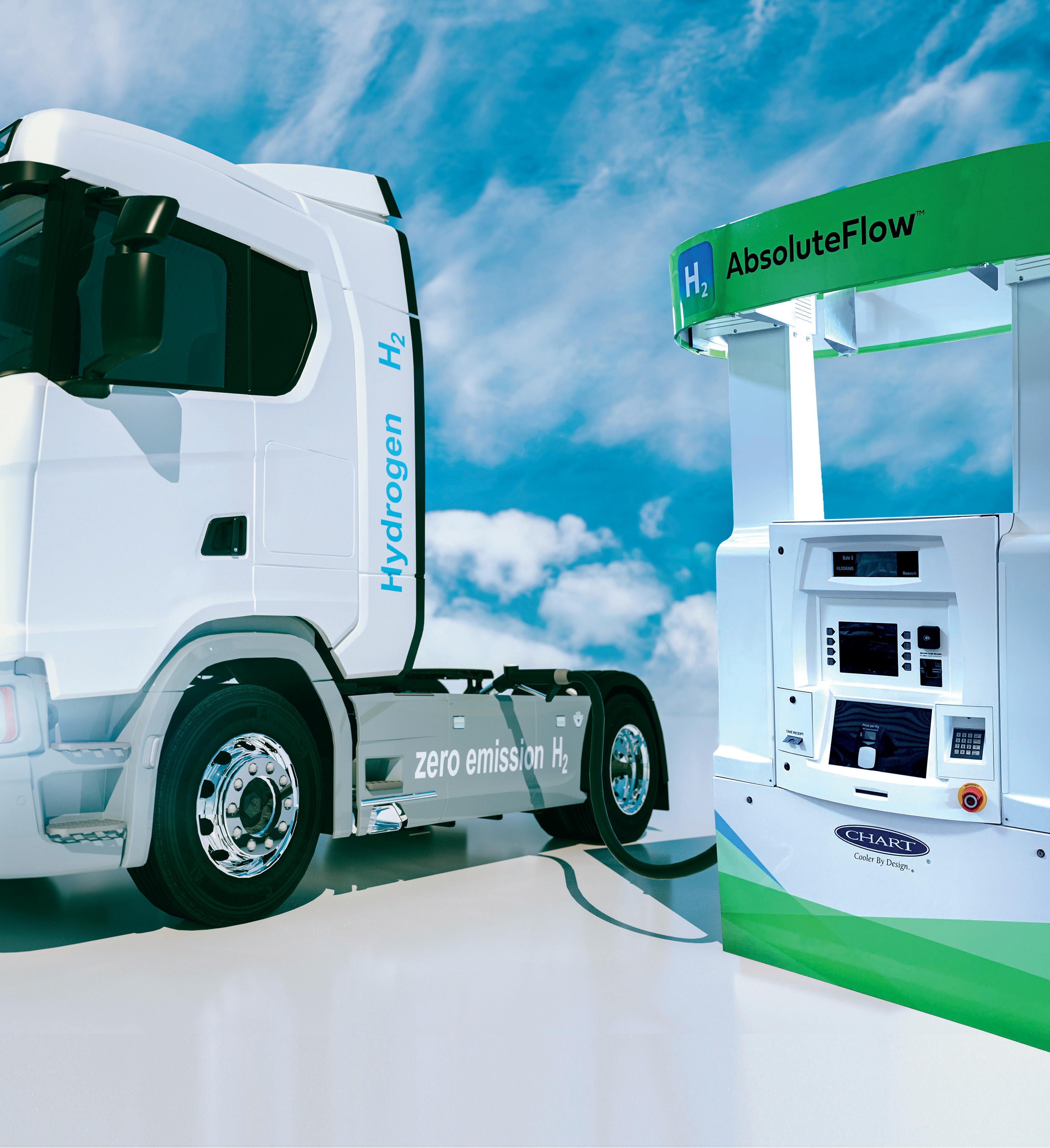

Autumn 2023 21 GlobalHydrogenReview.com www.ChartIndustries.com/Hydrogen hydrogen@chartindustries.com Americas: +1 800 400 4683 Germany: +49 (0)2823 328 224 China: +86 519 8596 6000 Scan to download our brochure Chart’s liquid hydrogen fuel stations allow for quicker fueling of vehicles with more dense liquid hydrogen, using simpler equipment and requiring less infrastructure investment. Chart’s HLH2 vehicle fuel systems provide greater range and payload advantages using liquid hydrogen storage and an integrated heat exchanger for Fuel Cell Electric Trucks (FCETs). HLH2 vs. H35/H70 • Lighter Weight • Smaller Footprint • Easier to Install • Faster Fill Times • Customized Integration with Truck Manufacturer’s Fuel Cell Engine
Alex Brierley and Lucy Whitford, HYRO*, UK, explore different ways to deliver green hydrogen to hard-to-electrify industries in the UK.
Achieving net zero requires a significant reduction of emissions across all parts of the economy, including heavy industries. The simplest way for the UK to reach net zero is to electrify the services used on a day-to-day basis, and to couple this electrification with a rapid rollout of local sources of clean renewable energy in the country’s power system. However, many of the heavy industries that manufacture the products that people use every day rely on processes that cannot be easily electrified. These are called hard-to-electrify sectors.
For these hard-to-electrify parts of the economy, alternative ways to decarbonise need to be found. Hydrogen produced from

home-grown sources of clean energy, such as wind and solar, can be cost-competitive and reliable. This solution could also play a positive role in the UK’s national and global net zero goals.
As well as providing a clean route to decarbonisation for some industrial businesses, green hydrogen will also create new high-skilled clean jobs. This will help cement Britain’s position as a leader in the green economy and contribute to the country’s levelling-up agenda. The shift away from polluting fossil fuels will also result in greater investment in sustainable growth.
The UK government has recognised the importance of hydrogen for some industries, and already has a target to have produced 10 GW of hydrogen from low-carbon sources by 2030.
22
Green hydrogen production process
There are several ways to deliver green hydrogen to industrial businesses, including:

y Producing the hydrogen onsite or near to the customer and delivering to that customer via a short dedicated pipeline.
y Producing the hydrogen in a different location to the customer and then delivering it via road transport.
y Delivering the hydrogen via a water-based transport solution.
y Delivering the hydrogen by a pipeline.
On a practical level, the second option is difficult for large energy users who require green hydrogen in large volumes.
23
While the third option could become more relevant as international trade for hydrogen expands, it remains challenging to transport hydrogen in a gaseous form, so it will likely need to be moved by converting it into ammonia instead.
The fourth option could also work for trade in the future, but as plans and timelines for public pipelines are not clear, this cannot yet be relied upon.
For these reasons, Octopus Energy is focusing on producing green hydrogen on site and close to the customer. It is then supplied to the industrial businesses on that same site. In this scenario, there is already an offtaker, and the hydrogen does not need to be transported. Octopus Energy believes that this is the best approach to focus on in the short-term. When considering the urgency to reach net zero goals, one cannot afford to wait for other areas to progress first and should instead look for solutions that are currently available.
To make this work, green hydrogen plants – tried and tested electrolysers � use electricity generated from sources such as wind and solar energy to split water and create hydrogen. This process is called electrolysis. The hydrogen created is green because it has been produced using renewable electricity. This makes the most of local, clean sources of energy when the weather is sunny and windy.
The green hydrogen plants built onsite also incorporate a water treatment plant, transformers, and AC/DC rectifiers to supply the electrolyser with electricity. Storage tanks with compressors pressurise and store the green hydrogen onsite, and the green hydrogen is fed through a hydrogen pipeline into an industrial hydrogen-ready boiler.
Case study
For Kimberly-Clark, where electrification was not fully possible in its manufacturing facilities in the UK, green hydrogen will now provide an incredibly helpful route to decarbonise the company’s manufacturing processes and drive down emissions.
Kimberly-Clark, the parent company of household brands in the UK including Andrex®, Kleenex® and Huggies®, uses both electricity and gas (thermal energy). Making this electricity renewable is possible through the adoption of solar and wind power. In April 2023, through partnering with Octopus Energy, a new onshore wind farm was developed which now generates around 80% of Kimberly-Clark’s UK electrical power needs. Kimberly-Clark is also exploring the use of onsite solar solutions.

However, decarbonisation of thermal energy is complex, and Kimberly-Clark has been continuing to look at different technologies – including electricity, hydrogen, biomass, biomethane and syngas. Each of these technologies has benefits, as well as complexities.
The combination of decarbonisation technologies that the business opted for was also influenced by energy markets and regulatory frameworks. In the UK there is a favourable framework in place for green hydrogen. Kimberly-Clark has accelerated its adoption of green hydrogen because it requires minimal process modifications. The company will also have the ability to store green hydrogen short-term to accommodate the ups and downs of daily production at its sites.
HYRO, Octopus Energy Generation and RES’ joint venture (JV), already has projects underway with Kimberly-Clark. The company expects to reduce its natural gas consumption in the UK by 61% when these green hydrogen projects are operational at the end of 2025.
The two projects HYRO is working on with Kimberly-Clark will see green hydrogen produced and supplied to the company’s manufacturing facilities in Flint, North Wales, and Northfleet in Kent, England. The two electrolyser projects will have a combined capacity of 22.5 MW and will reduce the business’ CO2 emissions by thousands of tons per year.
The green hydrogen plants will be built on the land next to the factories and fed straight into the hydrogen boiler inside the factory. Kimberly-Clark’s decision to step away from gas will help to reduce emissions and also boost energy security. As a result, everyday products including tissues and toilet paper will be produced in a way that is far better for the environment.
These projects set the stage for decarbonisation and create a blueprint for more industrial businesses to follow.
The future is green
HYRO was set up with a purpose to help hard-to-electrify industrial businesses to decarbonise through the adoption of green hydrogen. Green hydrogen is forecast to play a key role in the energy transition and delivery of net zero targets. In addition to the UK’s ambitions, other countries in Europe have outlined strategies that set targets for approximately 60 GW of electrolyser capacity to be installed by 2030.
These targets provide a strong signal for the market, and regulatory programmes developing to support meeting these targets provide a huge tailwind for the sector. A significant effort will certainly be required to realise these ambitions.
When electrification is not possible for industrial players, it is clear that green hydrogen will provide an increasingly vital route forwards for companies aiming to reach net zero. This is only the beginning for this burgeoning sector.
Note
24 Autumn 2023 GlobalHydrogenReview.com
* HYRO is a green hydrogen joint venture (JV) between Octopus Energy Generation and RES.
Figure 1. Kimberly-Clark’s Northfleet factory, UK. Credit: Kimberly-Clark.
energy carrier and fuel. The areas of application in the hydrogen industry are diverse: from production to distribution, through to transport, storage and utilisation.
Unlike other forms of hydrogen production – such as grey hydrogen, which is created from natural gas – green hydrogen is made from renewable sources. It offers a zero-emission solution as an energy carrier and fuel for transportation, power generation, heat in process industries or buildings, and energy storage.

into its oxygen and hydrogen molecules through an electrochemical reaction, without emitting CO2. Currently, there are two mature electrolysis technologies: alkaline electrolysis (AEC), and proton exchange membrane electrolysis (PEMEC). In both systems, water is split at the cathode to form hydrogen, and oxygen forms at the anode. However, these systems currently have a 60 – 80% efficiency rate, which represents the level of electrical energy that will be transformed into hydrogen. The remaining 20 – 40%

25
Evgenij Loginov and Alexander Gernhardt, Kelvion, Germany, analyse the heat exchange options that are available for electrolysis systems used in green hydrogen production.
becomes heat that can either be recovered and reused in district heating, for example, or emitted by air coolers into the ambient air. This means that an electrolyser system with 10 MW capacity will transform approximately 2 – 4 MW of the electrical energy supplied to the process into heat.
Therefore, electrolysis used to generate green hydrogen from renewable sources requires thermal management in order to operate efficiently. There are a number of heat exchanger options for plant designers to choose from.
Stability and efficiency
It is crucial that all equipment interacting with the electrolysis process is carefully designed and selected for optimum stability and efficiency. This is particularly important for the cooling system, which requires heat exchangers for transferring the heat within the process, and dry coolers for releasing the heat to the ambient air.
Typically, the main heat exchangers required are the central coolers for the main working circuit, i.e., water coolers for PEMEC or KOH/lye coolers for alkaline electrolysis. Additionally, hydrogen coolers/condensers and oxygen coolers/condensers are needed to cool and pre-dry the gases before they enter the downstream purification process.
For electrolysis systems, Kelvion offers three different heat exchanger types – plate heat exchangers; shell and tube heat exchangers; and radiators and dry coolers – all of which are suitable for both AEC and PEMEC processes.
When choosing the type of heat exchanger, there are several things to consider: CAPEX and OPEX; required footprint; safety; thermal performance; pressure and temperature resistance; materials; media; and serviceability. It is also important to consider potential future capacity increases and load changes.
Plate heat exchangers
A plate heat exchanger transfers heat between two media separated by plates that are sealed by gaskets, brazed, or welded together. The plates are configured to form flow channels through which the hot and cold media flow
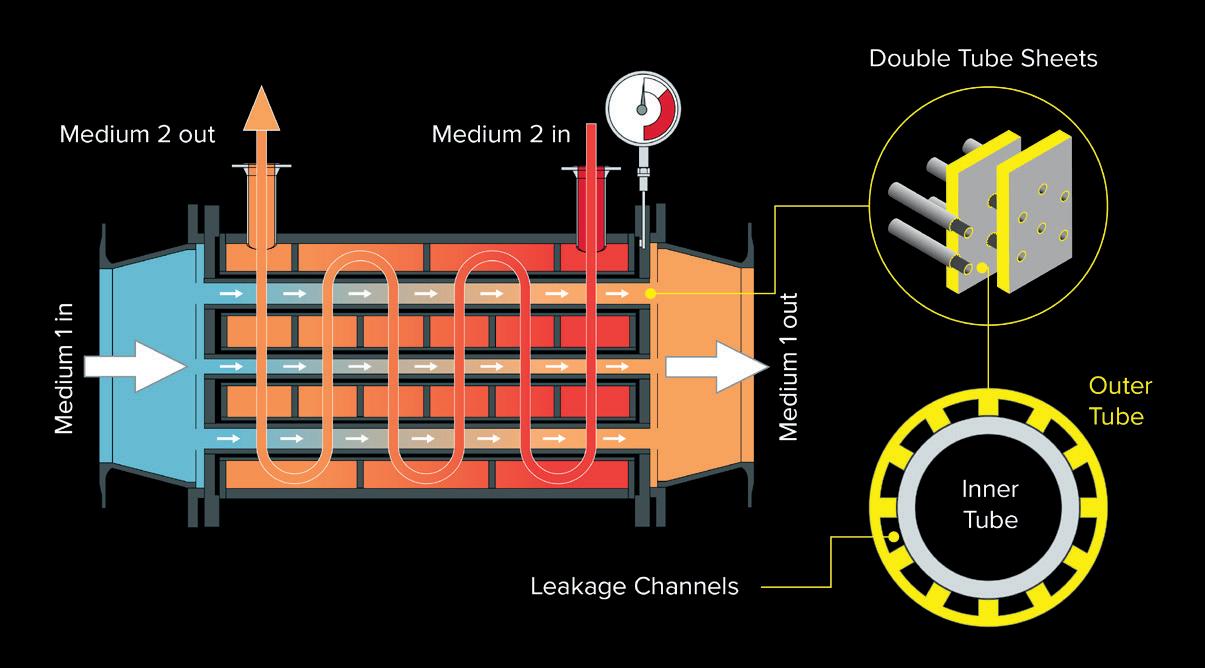
counter-currently, enabling the transfer of thermal energy from one to the other. This is made more efficient by corrugations in the plates that create turbulence in the media flow.
The gasketed, brazed and welded variants are similar in function, but may differ in configuration, structure and materials, depending on the application for which the heat exchanger is required.
Gasketed plate heat exchangers are compact and easy to maintain. Single gaskets and plates can be replaced, and more plates can be added to increase capacity. Although they are less resistant to pressure and temperature than other heat exchanger types, the limits are not disadvantageous for electrolyser systems for which they are ideally suited.
Kelvion models for this heat exchanger type have four notable features. Firstly, the OptiWave design of the corrugated plates, which allow the flow to be evenly distributed for maximum heat transfer and lower fouling rates. With the EcoLoc system, gaskets can be installed and maintained easily, while the PosLoc design enables plates to self-align and seal tightly every time the unit is closed, offering stress-free maintenance and operation over a long life cycle. Additionally, just one frame is needed, and this can be adapted with varying numbers of plates, allowing heat transfer capacity to be adjusted to meet changing needs. For applications with critical media and safety requirements that exceed the limits of conventional gaskets, plate cassettes with laser-welded flow channels are available.
Brazed plate heat exchangers have an individually-defined number of corrugated stainless steel plates bonded with copper, nickel or Vacinox in a vacuum brazing process. Thus, they are hermetically-sealed without gaskets.
This heat exchanger type is compact and fits easily into a containerised electrolyser, and is a highly cost-effective solution for oxygen coolers or hydrogen coolers. It also has a safety chamber feature that absorbs stress from thermal shock and pressure, preventing internal leaks and premature failure. This makes it a good option for PEMEC systems with short response times.
Shell and tube heat exchangers
As the name suggests, this type of heat exchanger comprises a tube bundle in a round shell. One medium flows within the tubes, and the second medium through the shell. Shell and tube heat exchangers are highly resistant to pressures and temperatures. They are widely used globally, as they can be easily customised to suit a broad range of industries, including hydrogen-related applications. However, this type is less efficient than a plate heat exchanger, which means that it requires more space.
Besides the single tube format, Kelvion offers shell and tube double safety heat exchangers, which provide optimum system reliability and high plant availability – an important consideration when dealing with hydrogen.
The tubes in double tube safety models have two
consisting
an inner and outer
26 Autumn 2023 GlobalHydrogenReview.com
walls,
of
Figure 1. Every tube has two walls, consisting of an inner and outer tube, as well as two tube sheets at each end. The inner tube is form-fit into the outer tube. This generates a joint integrity. One of the tubes is equipped with a profiling, which therefore results in a leakage room between the tubes. In case of damage, leakages are detected and an alarm is triggered while media are kept separate.


tube, as well as two tube sheets at each end. Should a tube wall become damaged, the product would flow through channels between the tubes, into a leakage collection space, triggering the leak detection alarm. As the second tube wall remains undamaged, the media are kept separate. This enables the plant operator to continue running the unit until the next planned maintenance, avoiding costly unplanned downtimes and contamination of the process and equipment.
Dry coolers
In electrolysers, dry coolers are used to dissipate the process heat into the ambient air. They are available in a wide range of sizes to suit small, containerised electrolysers, as well as large-scale electrolyser plants. Additionally, they can be designed as a modularised or centralised re-cooling format.
Media flows through a finned tube bundle that is exposed to the ambient air. Fans force the flow of ambient air through the bundle to increase the cooling performance.

The coolers are available in a flat bed and V-Bank format. In a flat bed unit, one bundle is placed horizontally, whereas in the V-Bank two bundles are placed in a V angle. The advantage of this is that, for the same cooling capacity, only 62.7% of the footprint is required. Both units can have one or two rows of fans, and multiple units can be combined in a system. To further reduce the footprint of the cooler, or increase the heat exchange performance, adiabatic systems can be installed. This can lower the footprint by a further 30%, depending on the relative humidity.
TGSim PlusTM
A REAL-TIME DYNAMIC SIMULATOR OF GAS TURBINES
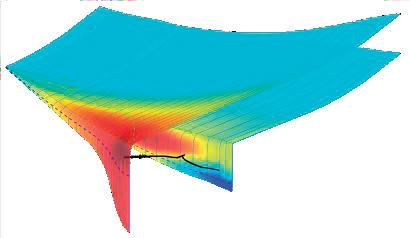
DESIGN AND ANALYSIS OF GT MAIN SYSTEM AND AUXILIARIES

GT CONTROL SYSTEM VERIFICATION & VALIDATION BY HIL TESTING

SCENARIOS
Verify and validate the real GT Control System (GTCS)
Hardware-in-the-Loop (HIL) full system testing
Whole system performance analysis:

▪ Accurate performance envelope
▪ Start-up sequences
▪ Normal and emergency shutdowns
▪ Load rejection
▪ Investigation of fault events
TECHNICAL DETAILS
0-D modelling
GT component modules libraries
Real-time compatibility at millisecond scale

User friendly GUI & pre-/post-processing tools
Split stages or whole compressor maps management
Different applications require individual solutions
The optimal heat exchanger choice depends on different factors, such as media temperatures; pressures; available space; safety requirements; and thermal performance.
Plate heat exchangers offer the best thermal performance, which is why they are the most compact option and potentially the best choice for containerised solutions. Gasketed plate heat exchangers offer great serviceability as they can be dismounted for cleaning. Furthermore, their cooling capacity can be simply increased by adding extra plates later. If equipped with laser welded cassettes, gasketed plate heat exchangers fulfil higher safety requirements. Brazed plate heat exchangers are suitable for low to medium thermal duty, and are the most cost-effective option, but are not serviceable as the plate package cannot be dismounted due to the brazing process in manufacturing.
Shell and tube heat exchangers are not the most compact heat exchanger type, but are very resistant to pressure and load changes. They are also available in a wide variety and combination of materials and alloys, which means that they can cope with different media. In a fully welded construction, or even as a double tube safety, this heat exchanger is designed to ensure a leakage-free operation, and to trigger an alarm if the tubes become damaged, preventing media contamination. This offers an extra layer of safety, especially for operations involving the small hydrogen molecule, and can render intermediate heat transfer circuits obsolete.
Given the current lack of design standards in the emerging green hydrogen market, it is vital that plant designers and operators choose the heat exchanger type that is the best fit for their needs.
GT MAIN SYSTEM
GT CONTROL SYSTEM
GAS AUXILIARIES
LIQUID AUXILIARIES
START-UP & SHUTDOWN GVA 2
Modelling & Diagnostic software for process plants and machines Simulation services Consulting
www.sate-italy.com Venice - Italy
GT MODEL ARCHITECTURE
Single or bi-fuel combustion chambers GVA 1
Peter Thomsen, Swagelok, Denmark, details how one Danish company is building a high-quality delivery system to make hydrogen the standard for renewable transportation fuels.
As the world seeks innovative solutions to its growing climate change dilemma, the search for a cleaner energy source is front and centre. For many, hydrogen may offer significant promise as a fossil fuel replacement, given that it can be extracted easily from substances
such as water, and it burns without emitting carbon dioxide (CO 2 ). The challenge facing the industry is not the source itself, but building the infrastructure necessary to deliver it to an energy-intensive industry such as transportation.
As the infrastructure is being built, the highest-quality materials

29
Busting four hydrogen myths
Myth: hydrogen gas is hazardous to use or store
This myth is especially persistent, despite the fact that hydrogen is no more hazardous than other traditional fossil fuels. In fact, the dangers are more often significantly lower because of its non-toxic and low-volatility properties. In addition, a properly designed hydrogen fuel system will include safety procedures and protocols that make all aspects of refuelling hydrogen vehicles much safer and more reliable than other options. If it is properly handled, green hydrogen will offer an efficient and economical solution for an ever-changing transportation sector.
Myth: hydrogen vehicles are not a practical long-range solution
Unlike traditional electric vehicles (EVs), hydrogen-powered vehicles have far fewer range concerns because of hydrogen’s high energy density. It is more appropriate for use in heavy-duty vehicles than battery technology because its lighter weight maximises the truck’s payload capacity. In addition, operators can refuel hydrogen vehicles much more quickly than those using traditional battery technologies. Typically, hydrogen vehicles can be refuelled in minutes, whereas traditional electric batteries can take hours – downtime that can significantly hurt a transportation company’s bottom line. Finally, green hydrogen is more easily stored, which allows clean energy to be supplied consistently, no matter what the weather is like.
Myth: hydrogen is too expensive
Although green hydrogen is not yet less costly than traditional fossil fuels, the price, following the trends in other renewable fuels such as solar and wind, continues to plummet. Over the next decade, its price is expected to fall precipitously, and the belief held by most experts is that it will eventually cost the same as, or less than, conventional fuels. In addition, governments are increasingly insisting on cleaner fuel standards, which are expected to speed up green hydrogen’s development.
Myth: hydrogen is not environmentally-friendly or sustainable
The myth that green hydrogen cannot be produced in an environmentally-friendly or sustainable way is based on an outdated conception of how hydrogen fuel is produced. Whilst it is true that hydrogen has traditionally been extracted from fossil fuels, it has been demonstrated that hydrogen can be extracted in an environmentally-friendly way from other sources. Additionally, hydrogen fuel cells produce no emissions except water vapour, which will necessarily reduce greenhouse gas generation around the world.
should be used to prevent leaks and allow the system to last for years or even decades – and not all components meet these stringent standards. Producing and handling hydrogen fuel are not easy processes. They require components that can perform according to strict criteria throughout the entire system. Four of the most important criteria to consider include:
y Pressures: to achieve the desired density, hydrogen must be stored in on-vehicle tanks at 350 – 700 bar.
y Stress and vibration: systems must be able to withstand high speeds, bumpy roads, and inclement weather.
y Safety: refuelling stations must be safe for an average consumer to operate.
y Maintenance: systems must be simple for technicians to access and remake leak-tight joints as necessary.
Within a hydrogen fuel system, the valves are instrumental in the system’s operation and should meet the highest possible standards. Leaks must be prevented at connection points and shut-off points, and valves should be able to operate effectively while maintaining integrity under the unique conditions associated with hydrogen applications.
Addressing the barriers to adoption
Until recently, the hydrogen industry faced several barriers that have hindered its mainstream adoption:
y Extremely small hydrogen molecules are challenging to contain under pressure.
y Much of the hydrogen produced has been extracted from fossil fuels, which renders it less environmentally-friendly.
y At the current time, no infrastructure exists to compress hydrogen into a useable fuel.
Fortunately, these three factors are becoming less important as the industry evolves, and one company in Denmark is central to making these initial concerns obsolete.
High-performance hydrogen valves are essential
Everfuel is working hard to introduce hydrogen into multiple fuel applications across the world, in an effort to eliminate fossil fuels. Its goal is to create a green hydrogen infrastructure to replace fossil fuels in industrial environments, as well as to distribute and dispense hydrogen to the transportation sector.
To achieve these goals, the company has created the HySynergy project, which initially aims to build a 20 MW power-to-X (PtX) hydrogen production facility that is able to produce and store significant amounts of green hydrogen before it is transported to end users and neighbouring refineries. The goal is to have established a 1 GW hydrogen plant that uses renewable power as the source of green hydrogen by 2030.
Wind and solar will be used to provide power to the plant, and it is expected to produce no emissions. The aim is to prove that green hydrogen makes sense from an
30 Autumn 2023 GlobalHydrogenReview.com
environmental perspective, and that it can be a sustainable business in the long-term. Not only will the hydrogen be produced using renewable sources, but the plant will also have the capacity to store it for future use, depending on the grid mix during that given timeframe.
The process will also be regenerative in another way: the byproduct of using hydrogen in fuel cell vehicles is pure water. This creates a virtuous circle that allows the facility to sell its waste heat and oxygen, as well as produce additional hydrogen – all without the use of fossil fuels. In addition, compressed hydrogen carries more energy than traditional batteries and other storage technologies, which means maximising the fuel produced against the amount of fuel used in its creation.
How to contain and compress hydrogen
Part of the challenge of producing green hydrogen is its small molecules, which can escape through even the tiniest openings. This is why creating a leak-tight environment during containment and compression is so crucial. Using valve components made from high-quality stainless steel can help to prevent leaks. Not only can hydrogen leak through small crevices, but it can also weaken the materials of the valves used to contain it. This process, called hydrogen embrittlement, can lead to material failure if lower-quality stainless steel is used. For this reason, it is important to find a supplier that can provide components that use the highest-quality materials, including stainless steel with a higher nickel content; and hydrogen-specific ball and needle valves that can stand up to the corrosive nature of hydrogen. It is also useful to choose components that are easy to install and service. This will save installation time and improve operational performance, while requiring less maintenance in the long-term.
Working with a trusted supplier, Everfuel has already begun to significantly lower carbon emissions for its customers that are using hydrogen. By 2025, when the second phase of the project is completed, the facility will be able to displace up to 500 000 t of CO 2 emissions in the sectors of heavy industry and mobility, which equates to 11% of the CO 2 emissions from the Danish land-based transport sector.

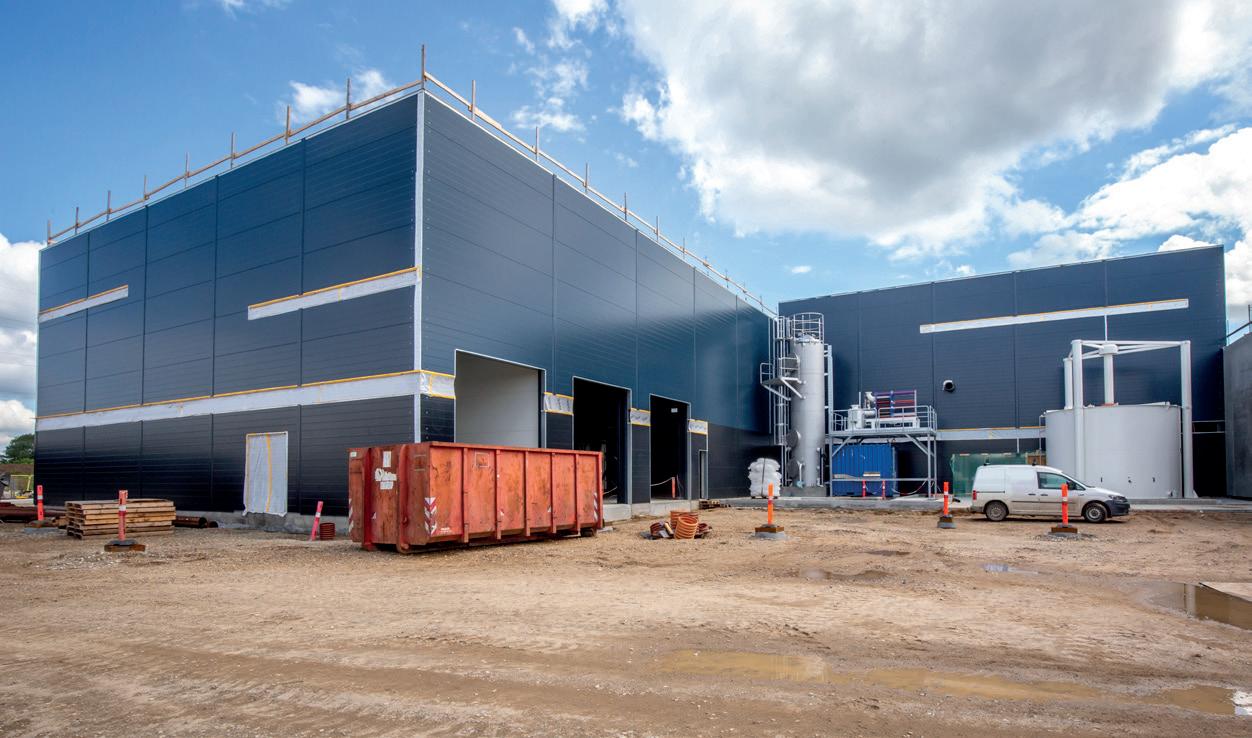

Autumn 2023 31 GlobalHydrogenReview.com
Figure 1. Everfuel is in the process of building a green hydrogen plant to run on renewable energy, producing no emissions during the extraction process.
Figure 2. Once Everfuel’s facility is completed, it is expected to serve as a future example of what is possible in the production of green hydrogen.
Figure 3. Everfuel’s hydrogen electrolysers, which convert water and electricity into hydrogen and oxygen, feature high-quality components to transport the hydrogen, minimising the risk of hydrogen embrittlement for safer operations.

32
Amidst growth in the clean energy technology sector, and continuous energy efficiency improvements, global energy-related carbon dioxide (CO2) emissions grew by 0.9% in 2022, reaching more than 36.8 Gt, according to a report from the International Energy Agency (IEA).¹ The net zero imperative remains, and so should the will to integrate and leverage innovation to accelerate progress towards decarbonisation, sustainability and electrification.

Decarbonisation is a key component of the future energy map to enable a zero-carbon society to grow, while reducing greenhouse gas (GHG) emissions. This implies upgrading production sites to produce energy in a cleaner manner, while nurturing the development of a global and domestic hydrogen value chain. Hydrogen needs full recognition as a secondary energy source that acts as an energy carrier that is able to be stored and converted to serve a myriad of applications in industry, transport, power generation and building. Achieving a successful energy transition is possible with current technologies that leverage hydrogen and carbon capture value chains.
There have been efforts to deploy renewable energy-based projects, with the intention of including all emerging and developing economies in this new energy move. All countries that are willing to deploy renewable energy projects face similar financial, administrative and regulatory hurdles that need to be addressed by the different private, public and institutional stakeholders at international, national and regional levels.
33
Marie-Laure Gelin, Howden, a Chart Industries Company, the Netherlands, explains why compression is such an important process within the hydrogen value chain.
These hurdles contribute to the delays in the number of renewable energy projects reaching the final investment decision (FID) stage. One of the factors behind the lagging scale-up of hydrogen production, transfer and distribution may be the lack of infrastructure serving the hydrogen value chain to allow it to become a ‘consumable product’. To overcome this situation, gas pipeline mitigation and hydrogen derivative products use existing infrastructure in ports and airports where possible. Under these conditions, it is difficult to assess whether this infrastructure is supporting or indeed slowing down the development of a hydrogen value chain.
The hydrogen industry needs to address the challenge of scaling up production to deliver the required quantities at the speed and price that end users can work with within their specific applications. One answer to this complex goal is to create integrated hydrogen value chains.
Compressed and liquid hydrogen
Companies are currently investing in cleaner ways of producing energy, by rethinking existing processes and implementing new processes. Unleashing the power of hydrogen molecules requires operators to move them to a supply site as and when needed, which is why storage options are important, whether as compressed gas, liquid hydrogen, hydrides, or liquid organic hydrogen carriers.
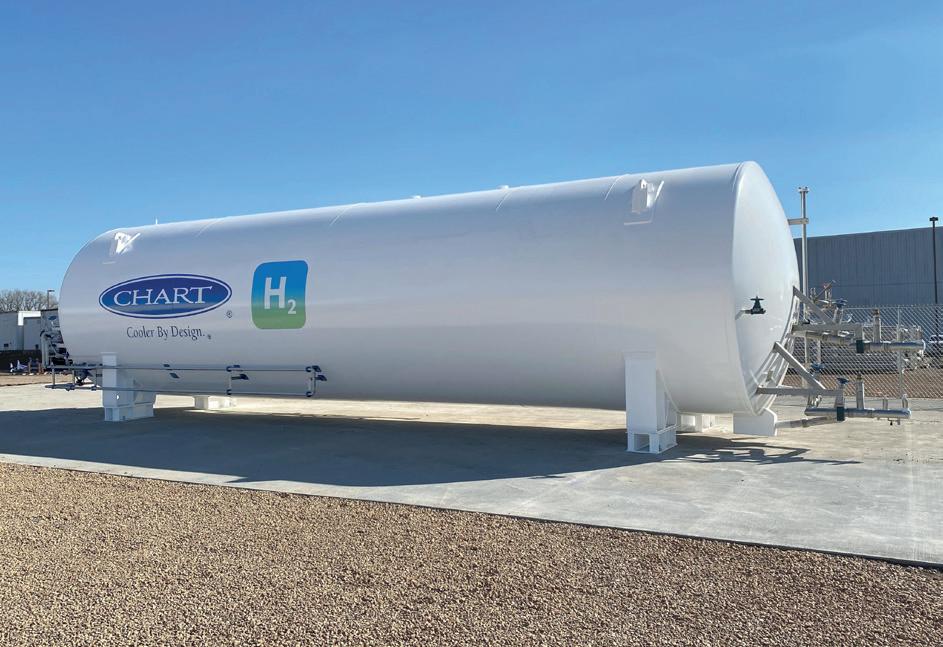
Depending on a value chain’s characteristics, liquid hydrogen is usually preferred for long storage periods and long transportation distances in large quantities. This form of hydrogen can be associated with compression in accordance with the final destination and use of the hydrogen, as well as liquefaction itself. Storing, transporting, transferring and converting (gas to power) hydrogen is challenging due to its poor volumetric density.
Liquid hydrogen and gaseous hydrogen technologies can respectively support a hydrogen value chain from production to final usage. Currently, depending on application requirements, infrastructure cross border trade, inland infrastructure, technology availability and market adoption, one value chain may associate liquid hydrogen and gaseous hydrogen stages.
Ultimately, the application’s purpose and customer circumstances are best to define what to use and where in the hydrogen value chain, as both liquid hydrogen and gaseous hydrogen come with their respective challenges and benefits. The question is not to prefer to manage low, cryogenic temperature properties or high pressure hydrogen. Rather, what is going to be the easiest given customer constraints and needs. Similarly, liquid hydrogen is more volumetrically efficient than gaseous hydrogen (e.g., liquid hydrogen is three times more dense than the common 300 bar pressure gaseous hydrogen transports). This said, gaseous hydrogen is serving today’s applications that need local distribution and modest volumes.
Compression is a key aspect of the hydrogen value chain, but not the only one. A hydrogen value chain demands coherence and integration, from hydrogen production through to its final usage point.
Market segmentation: demand/supply/infrastructure
Primary energy sources such as natural gas and conventional fossil fuels, as well as renewable energy sources, surplus energy (heat and electricity), and biodegradable waste can all be used as feedstock for hydrogen when using electrochemical (electrolysis), thermochemical (gasification, pyrolysis, steam reforming) and biological processes. The produced hydrogen can be liquefied to allow for transportation by sea tanker, trucks, and railway tankers for international shipping or domestic distribution.
In parallel, traditional industries are discovering cleaner ways to produce end products such as green steel, green and blue ammonia, e-methanol, renewable diesel, and biofuels (e.g. sustainable aviation fuels [SAFs]). All of these products follow strict processes, and require hydrogen compression.
The energy transition makes up a significant portion of Chart Industries’ business − consisting of hydrogen, biofuels, LNG with carbon capture, utilisation and storage (CCUS), nuclear power, electrification and water treatment.
Compression is a key element of the hydrogen value chain, starting at its production site to ensure that its pressure is relevant to its further transportation, distribution and utilisation. Renewable hydrogen production by way of electrolysis, followed by compression, would appear to be a cleaner way to produce energy. However, until this process scales up, many alternatives exist, such as blue hydrogen.
When producing clean hydrogen using carbon capture, specific CO2 compressors are required as part of the
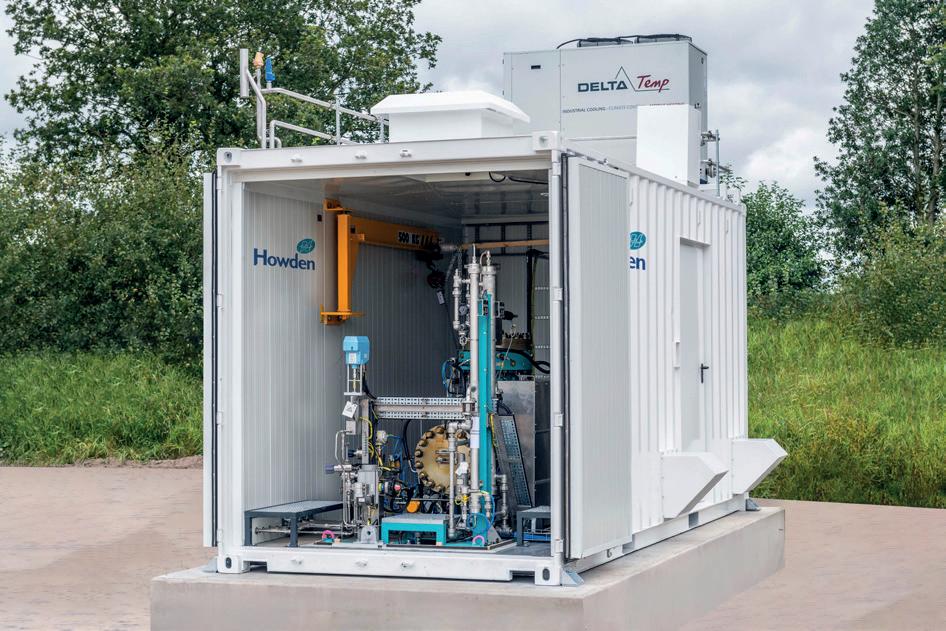
34 Autumn 2023 GlobalHydrogenReview.com
Figure 1. A green hydrogen compression solution with a containerised Howden diaphragm compressor.
Figure 2. A Chart hydrogen tank at the storage stage of the hydrogen value chain.
WE’RE COMMITTED TO A BETTER FUTURE
WE’RE COMMITTED TO A BETTER FUTURE
Optimizing combustion for a greener tomorrow
There has never been a greater need to decarbonize fired equipment, produce cleaner energy sources, and operate in a more environmentally responsible way.
Optimizing combustion for a greener tomorrow
There has never been a greater need to decarbonize fired equipment, produce cleaner energy sources, and operate in a more environmentally responsible way.
Optimized combustion and enhanced predictive analytics are key to reducing plant emissions and ensuring equipment uptime. Designed for safety systems, our Thermox® WDG-V combustion analyzer leads the way, monitoring and controlling combustion with unparalleled precision.
Optimized combustion and enhanced predictive analytics are key to reducing plant emissions and ensuring equipment uptime. Designed for safety systems, our Thermox® WDG-V combustion analyzer leads the way, monitoring and controlling combustion with unparalleled precision.
Setting the industry standard for more than 50 years, AMETEK process analyzers are a solution you can rely on. Let’s decarbonize tomorrow together by ensuring tighter emission control, efficient operations, and enhanced process safety for a greener future.
Setting the industry standard for more than 50 years, AMETEK process analyzers are a solution you can rely on. Let’s decarbonize tomorrow together by ensuring tighter emission control, efficient operations, and enhanced process safety for a greener future.

AMETEKPI.COM/CLEANENERGY
AMETEKPI.COM/CLEANENERGY
value chain. During hydrogen liquefaction, compressors are required for the feed to the liquefaction process itself (pre-cooling and cooling). Once the liquid hydrogen reaches a port, regasification occurs, so hydrogen molecules can reach their final destination using pipeline, tanker and bottling.
Compression technology based on reciprocating piston, diaphragm, centrifugal, screw or turboexpander technology enable large and low volumes of hydrogen and associated low or high pressures to obtain the required energy values, while managing pressure differences through the transfer and storage of hydrogen, with the highest gas purity when required. Developments in materials, lubricants, seal and valve design – together with computer-aided analysis and design –have resulted in proven marginal improvements in efficiency, reliability, and extended mean time between maintenance (MTBM).
At every stage of the value chain, hydrogen safety is paramount in order to erase the possibility of leakage, as its dangers can translate physically through embrittlement and failures; physiologically by asphyxiation; and chemically in the case of fires and explosions.
The first page of Chart’s safety manual illustrates the company’s values: “If it can’t be done safely, don’t do it. A job is well done only if it is done safely. Most accidents and injuries are preventable – no business objective is so important that it will be pursued at the sacrifice of safety.”
The Chart team continues to meet international safety standards and obtain certification. Many of the company’s
safety programmes and practices reflect requirements of the ISO 45001 Occupational Health and Safety standard for management systems. Chart voluntarily certifies certain manufacturing and fabrication facilities to this internationally recognised standard to increase safety and reduce workplace risks. Many of the company’s Specialty Products; Repair, Service and Leasing; Cryo Tank Solutions; and Heat Transfer Systems sites are ISO 45001 certified, and the company also assists sites that increase their work scope or are newly acquired in becoming certified.
Safety is the top priority and in 2Q23, Chart reported its lowest total recordable incident rate (TRIR).
Responding to a situation at the compression level
Compression at a hydrogen production site guarantees hydrogen gas transfer further down the value chain. In regions where renewable energy is produced a long way from where it is consumed, customers order diaphragm compressors as a compression solution for tube trailer filling so that hydrogen can be dispatched where required.
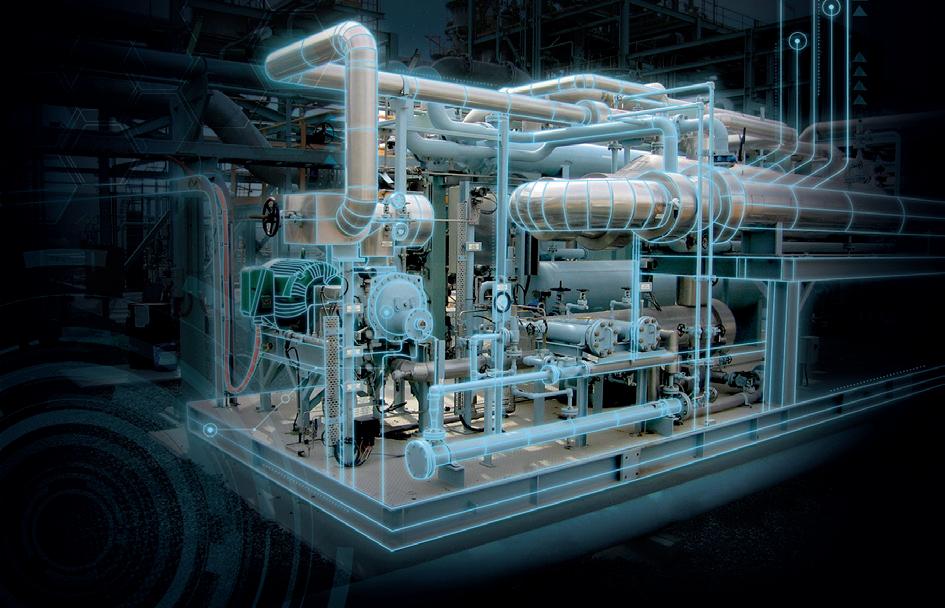
Downstream compression enables hydrogen gas to be delivered at the pressure that is required by the end use application, and so with the help of compression technologies, deploying green hydrogen at scale can become a reality. When compressed, the gaseous hydrogen can be used to decarbonise heavy-duty trucks.

Chart’s Howden diaphragm compressors enable the safe and efficient transportation of compressed gaseous hydrogen, ensuring its availability as a clean fuel source for heavy-duty trucks. This solution focuses on ensuring the safety and efficiency of hydrogen compression, while providing ongoing support to optimise plant performance and reliability.
Compression is involved in the production process of biofuels and e-fuels to decarbonise the transportation sector. Hydrogen compressors have the capacity to serve container vessels operating on carbon-neutral fuel produced from green hydrogen. This is in line with the adoption of the Marine Environment Protection Committee in July 2023 – a revised strategy to significantly curb GHG emissions from international shipping, with the ultimate goal of achieving net zero emissions by 2050. Chart’s Howden compression solutions support the production process of hydrotreated vegetable oil (HVO), leading to SAF production from bio and waste feedstocks, and sequestering CO2. Compressors are in action in various parts of the world, supporting synthetic processes to deliver e-methanol.
Conclusion
In support of the energy transition and the drive towards cleaner and more efficient operations, Chart Industries is involved in a number of projects in all parts of the world. The company has a number of different gaseous and liquid hydrogen technologies to help meet current challenges and customer expectations, depending on the application.
Reference
1. ‘CO2 Emissions in 2022’, International Energy Agency (IEA), https://www.iea.org/reports/co2-emissions-in-2022
36 Autumn 2023 GlobalHydrogenReview.com
Figure 3. Global service team working on a compressor.
Figure 4. Integration to the unmanned concept of the plant using uptime (digital driven advantage and digital twin).
Alittle over a century ago, in 1922, Willis Carrier installed the first practical centrifugal refrigeration compressor. It was a significant moment.
Although mechanical refrigeration equipment had by then been around for decades, their large size and cost restricted usage. Much safer to use, with a more compact and powerful design, the Willis Carrier installation became the foundation machine for the development of safer, more compact, and more powerful centrifugal refrigeration compressors.
Starting with inline machines and later evolving with integrally geared designs, centrifugal compressors have become the backbone of industrial-scale gas handling. Present in countless industries across the planet, these workhorses are designed to run reliably for years, only pausing for the usual maintenance intervals. Whether they are driving a chemical process, refining hydrocarbons, operating as a heat pump, or feeding air to a biological process, the users of these machines rely on them to keep their processes going.
Over the decades, the technology has improved, and become more efficient and reliable. For example, the development of dry gas seals has significantly reduced gas leakages and allowed for safer handling of hazardous gases. Advanced analytical tools have

led to the development of impellers that are capable of compressing with over 90% polytropic efficiencies. Advances in manufacturing have allowed for the machining of these highly customised impellers, along with extremely precise rotors, bearings, and gearing capable of operating at over 50 000 rpms.
101 years after Willis Carrier led the way with his machine, centrifugal compressors are still making a difference; notably at the forefront of developments in the hydrogen industry.
High reliability
The success of centrifugal machinery is underpinned by its very high reliability. This can be demonstrated by the fact that a machine’s hydrodynamic bearings are designed to operate with infinite life if the oil is well maintained. The impellers operate with close running clearances to the shroud, without any wearing surface. The dry gas seals float on a cushion of gas only a few microns wide, while the gearing is machined to tolerances that allow for 20-plus years of reliable operation.
All of this allows the compressors to efficiently put kinetic energy into the gas stream through the impeller, to then slow the gas back down, and to convert that velocity into potential energy or pressure at the outlet.
37
Todd Gibbs, Atlas Copco, USA, explains why centrifugal compressors will be key to developments in the hydrogen industry.
This is drastically different to reciprocating or screw compressors, which reduce the volume of the gas to increase the pressure, a process referred to as ‘positive displacement compression.’ With positive displacement compression, the moving elements are in contact with a wearing surface, or fluids such as oil are used for sealing that will carry over into the process stream. There are also positive displacement diaphragm compressors that do not use sliding surfaces or oil for compression – however, these tend to be much smaller volume applications than would be considered for centrifugal applications.
Selecting the right type of technology is key. As mentioned, the centrifugal compressor utilises kinetic energy to compress the gas. As gas volume increases, centrifugal impellers become more efficient at transferring this energy into the gas. The density of the gas also has a significant effect on this. As the density increases, it becomes easier to transfer energy into the gas.
The hydrogen challenge
On the one hand, the extreme low temperatures required for liquefaction provide a challenge for all technologies. Hydrogen’s low mole weight of 2 can be a significant challenge for centrifugal technology, though advancements in materials, impeller designs, and improved rotodynamic tools have helped to combat this.
On the other hand, the benefit of liquifying hydrogen is the immense reduction in volume, by 800 times compared to gaseous hydrogen. This can be seen when comparing truck transport at pressure: one truck of liquid hydrogen will carry the same amount as eight trucks of compressed hydrogen.
Once liquified, the need to manage the boil-off gas needs to be considered. In this case, the cold temperatures increase the density of the gas to the point that an integrally geared compressor is effective. An integrally geared compressor has the added advantage that the impeller is overhung and can therefore be separated from the bearing and seal. In this way, the extreme cold can be insulated from the gearbox (which otherwise would prevent the oil from properly lubricating the bearing) and heat from the gearbox does not migrate to the gas.
The housing can also be designed with a double wall and vacuum jacket to help insulate the gas stream from heat ingress. This reduces the amount of energy needed to reliquefy the boil-off gas once captured. With a liquid point of 20°K, every single degree matters.
Liquifying hydrogen
At the centre of refrigeration during hydrogen liquefaction is an integrally geared compressor, often with a pre-cooling loop based on a nitrogen-brayton cycle. Nitrogen has a mole weight of 28, which makes integrally geared compressors well suited for its compression. Each stage of compression is followed by a cooler that increases the density of the gas and improves the efficiency of the compression cycle. For this, the compressor is driving the loop and it works in conjunction with turboexpanders to provide the first cooling step in a multi-step process.
However, with a liquid point of -195.8°C, nitrogen alone cannot reach the extreme temperature of -252.87 °C that hydrogen liquefaction requires. Therefore, a secondary (or sub-cooling) loop is often used to circulate hydrogen as the working fluid, which means the compressor driving this loop is handling warm hydrogen. For this reason, a reciprocating compressor has become a better choice for this role. The combination of smaller volume, low density, and high pressure ratio being used in smaller plants today make centrifugal compressors a less attractive prospect. However, as plant sizes increase and centrifugal technology advances, this may quickly change.
Even in these loops, centrifugal compressors can operate as the brake for the turboexpanders. The energy that is used by the compressor wheel is removed from the hydrogen stream to draw the maximum amount of energy from it, resulting in the cooling required to reach the liquid phase. If research shows that other gases are suitable for these systems, the choice of technology may also change. Neon, for example, with a mole weight of 20 and a liquid point of 27°K, would be a prime candidate for this secondary cooling loop using an integrally geared compressor.


Producing, storing, and transporting hydrogen
The main sources of hydrogen are either from the electrolysis of water or from cracking methane. In the electrolysis process, electricity is applied to two sides of an electrolyser, causing the water molecules to split, drawing hydrogen to one side and oxygen to the other. The hydrogen is drawn off the top of the column and then compressed for storage or sent to be liquified. Green hydrogen is produced via electrolysis when the electrical
38 Autumn 2023 GlobalHydrogenReview.com
Figure 2. Integrally geared compressor.
Figure 1. Impeller and integral gearset.
MOBILITY SAF E-fuels HYDROGENATION DEHYDROGENATION STEAM REFORMER INDUSTRY CO₂ CCUS PURIFICATION PURIFICATION H2 UNDERGROUND STORAGE POWER GENERATION LOHC (TOLUENE) LOHC (MCH) ELECTROLYZER DAM Axens Activity CO2 H2 H2 COMMODITY Click here Your roadmap to Low Carbon H2 Discover Axens Solutions for the Production, Transport & Storage and Purification of Hydrogen
supply is from a renewable energy source, such as wind or sun. Pink hydrogen also uses the same process but is sourced from nuclear power.
When the source is from a cracking process, the hydrogen will be called blue if the CO2 produced is then captured, or grey if the CO2 is released. When the CO2 is captured with a mole weight of 44, it becomes another ideal candidate for integrally geared centrifugal compression.
When hydrogen is stored and transported as a compressed gas, it is commonly compressed to around 500 bar. For this application, positive displacement equipment works best. Depending on the electrolyser pressure, the hydrogen may or may not need further compression to be liquified. This process also produces a large amount of oxygen, and for small plants it can simply be released. With time, as the production volumes increase, this can also become a viable income stream. With oxygen in gas form, a mole weight of 32 presents an ideal opportunity to utilise centrifugal compressors to move the oxygen to a point of use or liquified for transport.
When to consider a centrifugal compressor
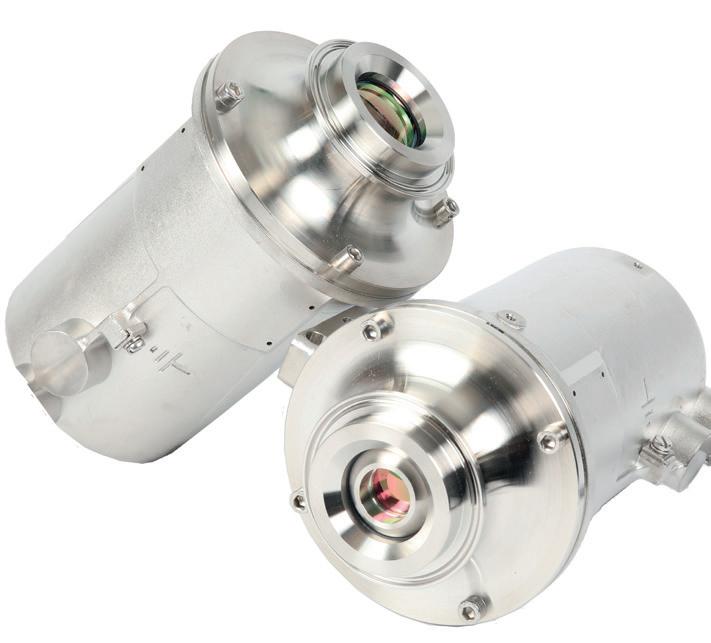
When considering whether or not to use a centrifugal compressor, the first thing to think about is the actual volume of the gas (not to be confused with normalised volumes 'Nm³/hr' or standard volumes 'SCFM'). As a simple starting point, a centrifugal compressor comes into consideration at above 2500 m³/hr. However, the inlet volume is not the limiting factor.
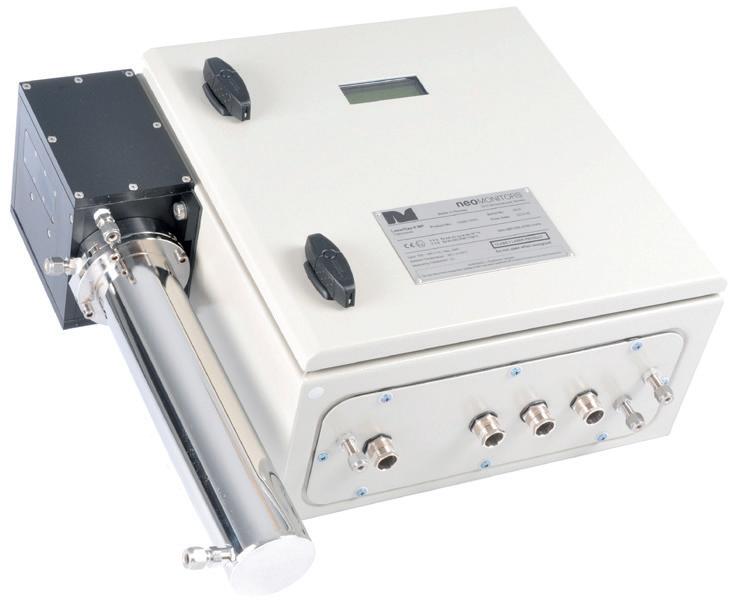

Since integrally geared compressors can have up to eight stages of compression, the volume into the last stage of compression is important. Another very rough guideline would be around 1000 m3/hr at the outlet of the compressor. The second thing to consider is the mole weight of the gas. Overall, once the mole weight starts to reach double digits, centrifugals are able to effectively impart kinetic energy into the gas stream. As the mole weight increases, a centrifugal compressor can deliver more pressure ratio per stage with the same impeller. Cooling the gas between compression stages also increases the density into the next stage, further increasing the efficiency and increasing the pressure ratio for a stage. Even with a low mole weight, lower temperatures can make centrifugal compression possible. With hydrogen boil-off gas, for example, the low temperature increases the density to around 0.85 kg/m³. At this density, the compression ratio needed is well within the limits of a single-stage compressor.
Hydrogen’s future
A century after the first reliable, safe, and powerful centrifugal refrigeration machine was installed, modern versions are now being employed in a variety of industries across the planet. Today, demand for hydrogen is expected to grow substantially, and centrifugal refrigeration compressors are playing a leading role, including in production, storage, and transportation. Although there are still challenges, decades of technological developments and innovations mean that centrifugal machinery will be central to hydrogen’s future.
WE ARE READY FOR THE GREEN FUTURE
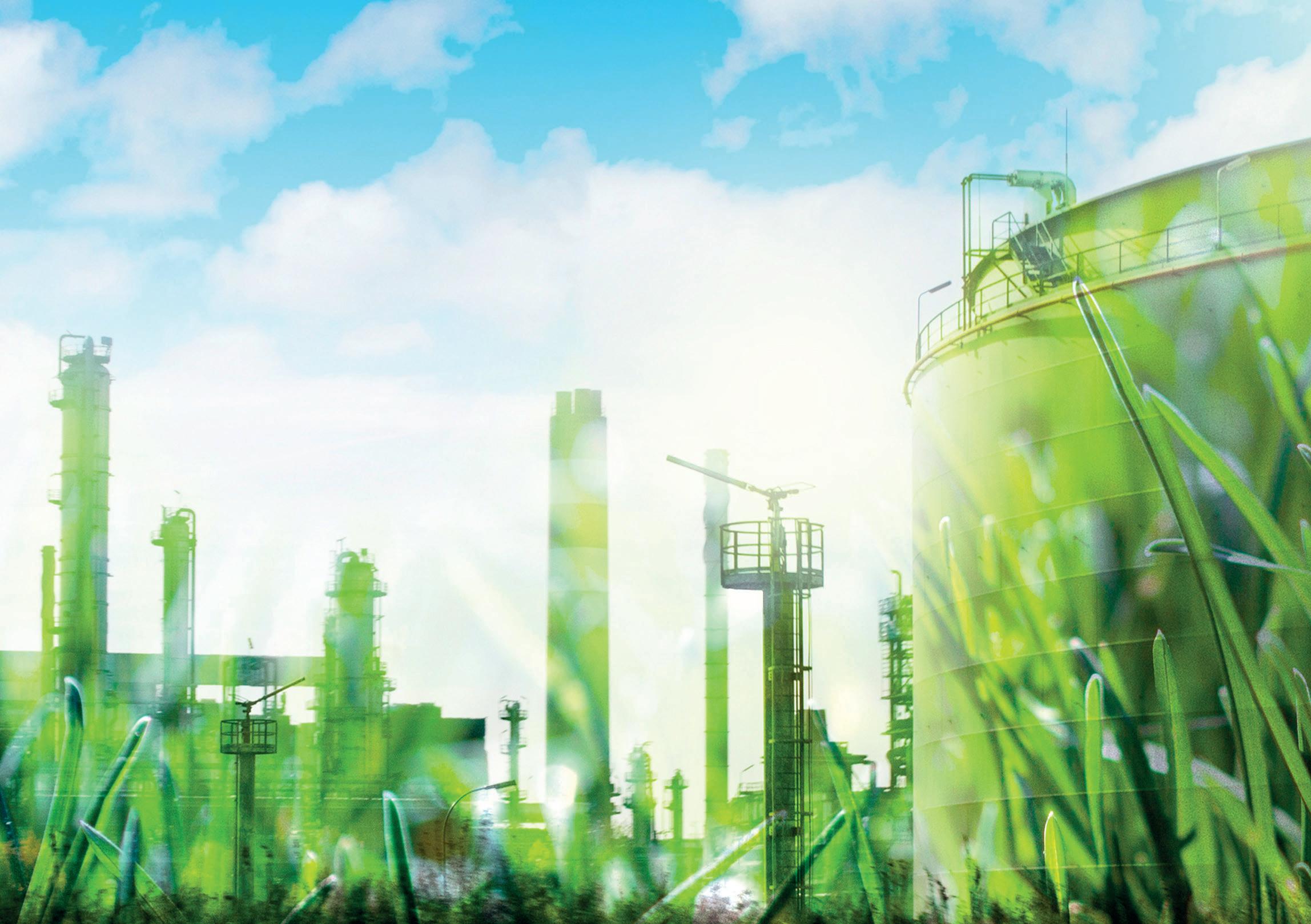
Performance You Can Trust LaserGas™ III SP & OP Designed for safety applications in process control and leak detection; available in single path and open path configuration. LaserGas™ II MP Measure impurities in Hydrogen and Carbon Dioxide with our highly selective and sensitive extractive multipass analyzers. www.neomonitors.com
Daniel Ballorca, Hiperbaric, Spain, explains why high-pressure compressed hydrogen is the most efficient way to store energy.
The hydrogen economy is already a reality, but there is a long way to go in terms of researching and developing new technologies, processes and solutions along the entire value chain, to facilitate its wide-scale deployment and use. High-pressure hydrogen compression is one of the technologies in question.

41
Hydrogen presents storage challenges due to its low density at ambient temperature and pressure. The most basic and straightforward way to make hydrogen dense, for use in a number of applications, is to compress it at very high pressures.
The most developed compressors that are currently available on the market are piston compressors and membrane compressors. Both of these compressor types can be either mechanically or hydraulically driven. Both technologies base their operation on the displacement of
hydrogen, i.e., on the reduction of the volume of hydrogen, instigating an increase in fluid pressure.
Due to the properties of hydrogen, the required compressors must have special characteristics. Piston compressors are used to reach very high discharge pressures, but with a different design than can be used in the compression of air or nitrogen.
This article will explore a compression solution that is capable of compressing hydrogen gas from a suction pressure of 20 bar to a maximum discharge pressure of 950 bar. This wide range of inlet and outlet pressures allows this compressor to be used during production, being able to be fed directly from an electrolyser, or in a medium-pressure storage tank such as tube trailers (at 200 bar).
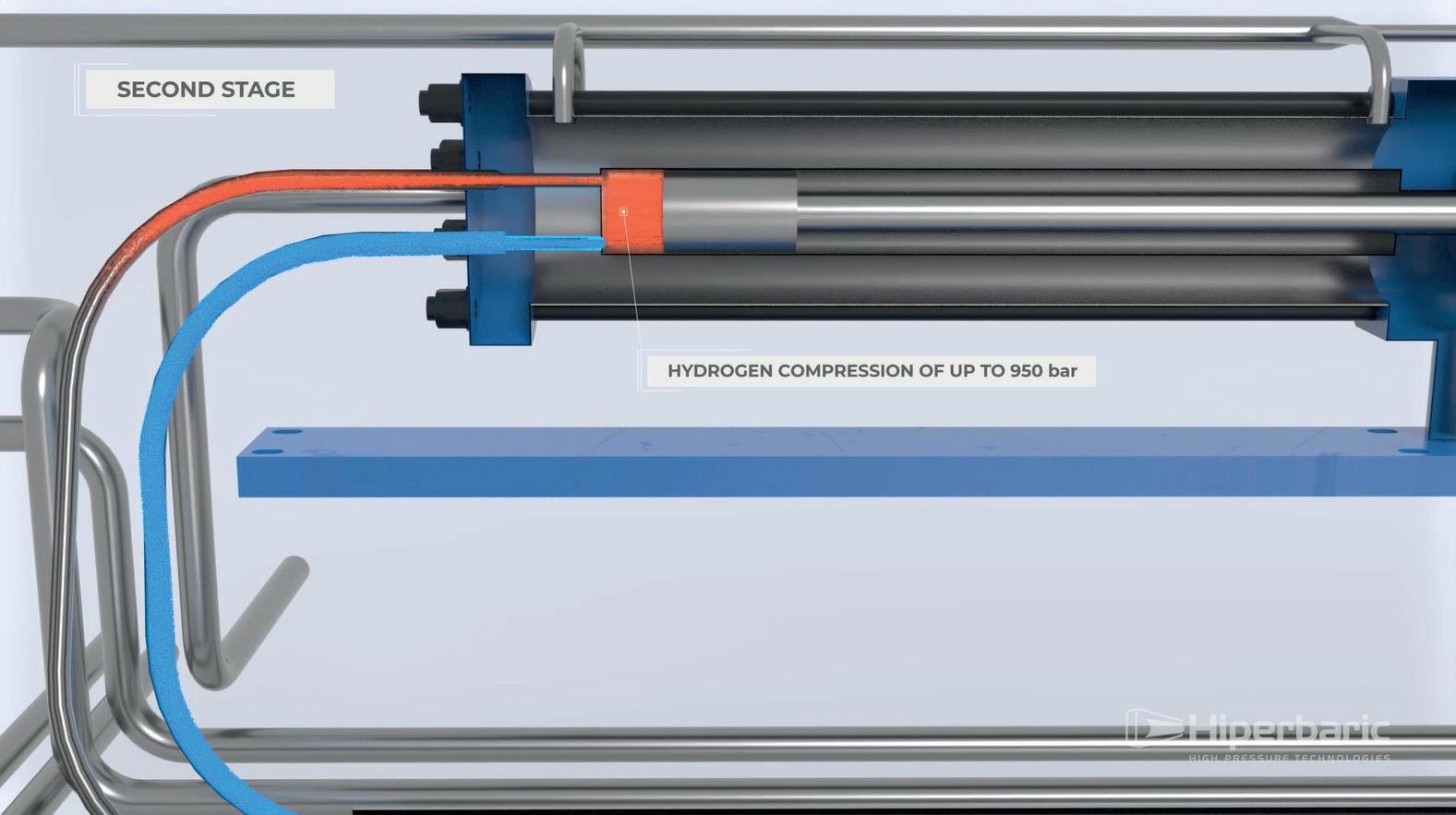
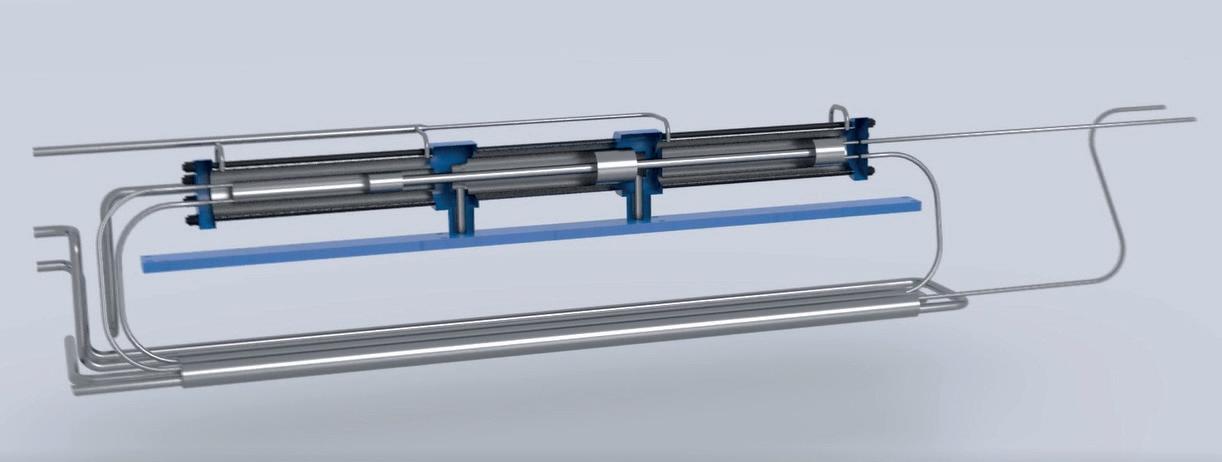
High-pressure compression
The compression system is housed inside a container specially designed for this application, which also includes all of the power, control and cooling elements necessary for its correct operation, including the following:
y An electrical power panel.
y A hydraulic system to drive the pistons inside the cylinders.
y A control panel.
y A venting circuit with monitoring to evacuate and stop the equipment in case of gas leaks.
y A cooling system for gas and compression stages.
The compressor consists of two compression stages, driven by an intermediate hydraulic drive system. The connecting rods of each piston are connected to an intermediate cylinder whose piston is hydraulically driven, producing a horizontal movement on the pistons that results in one stage sucking in the hydrogen, whilst the other compresses it.
In the first stage, the gas enters the cylinder at a pressure of between 20 – 200 bar, depending on the application. The hydraulic drive system moves the piston that compresses the hydrogen.

42 Autumn 2023 GlobalHydrogenReview.com
Figure 1. The compressor consists of two compression stages.
Figure 2. In the first stage, the gas enters the cylinder at a pressure of between 20 – 200 bar.
Figure 3. At the second stage, hydrogen reaches 950 bar.
Capture up to 99% of your low-carbon hydrogen production emissions.
Unleash your full blue potential.
With our new ATR technology powered by Casale and Technip Energies expanding our extensive range of proprietary SMR technologies, BlueH₂ by T.EN™ now delivers tailored, largecapacity, ultra-blue solutions with up to 99% emissions capture.

Unleash low-carbon hydrogen at any scale or type of plant with minimum carbon footprint for the lowest levelized cost now.
technipenergies.com

The gas leaves this stage at an intermediate pressure, and is sent to the second stage through a heat exchanger to reduce its temperature.
In the second stage, the process is repeated, reaching a pressure of 950 bar. Again, the compressed hydrogen is sent to the heat exchanger, and from there to the storage facility.
One of the key characteristics in the use of hydrogen is that it must be free of contaminants. For this reason, the compression system is totally oil free, i.e., the gas is not in contact with the compressor’s lubrication and hydraulic system, thus producing high-purity hydrogen.
When compressing hydrogen, as with other gases, a balanced design is required because the work effected during the compression stage is transformed into heat that must be dissipated. That heat must be extracted at an adequate rate to keep the hydrogen at a safe working temperature. To achieve this, the compressor incorporates a high-efficiency cooling system that reduces the hydrogen temperature to below 40˚C.
The compressor cooling circuit is divided into two parts:
y Gas cooling: this is carried out in two heat exchangers located between the compression stages. The first exchanger reduces the gas temperature at the outlet of the first stage, before entering the second stage. The second exchanger reduces the temperature of the hydrogen before it is sent to storage for later use.
y Cylinder cooling: another hot spot occurs in the compression cylinders. To reduce the temperature, each cylinder is fitted with special liners through which the cooling fluid circulates to lower the temperature of these elements. The cooling system is completed by a refrigeration chiller that reduces the temperature of the coolant, forming a closed circuit within the container package itself.
Innovations
The ‘oil-free’ concept of different components of the compressor means that contact between gas and oil is avoided, producing hydrogen of high purity. The design of the compressor sleeves allows for more efficient cooling, and the general design of Hiperbaric’s compressor group ensures high compression efficiency, while requiring less energy.
Either one or two compressors can be used, depending on the desired hydrogen flow rate. The plug-and-play solution is also safe and reliable, thanks to the vent system that monitors, evacuates and stops the compressor from any possible gas detection.
In addition, the general design of the compressor group ensures greater compression efficiency while requiring less energy.
These compressors are also manufactured in accordance with the strictest international directives, regulations and standards, offering reliability.
Renewable hydrogen agreements
Hiperbaric has strategic agreements in place with different players in the hydrogen value chain. One of the company’s agreements is with French company, Lhyfe. This collaboration will see Hiperbaric supplying and delivering renewable and green hydrogen compressors to Lhyfe in several locations throughout Europe in the next two years.
Additionally, Hiperbaric’s compressor technology was installed in Germany for a Framatome green hydrogen refuelling station for public buses. The company’s compressors are also part of a Spanish green hydrogen project, ‘Green Hysland – Power to Green Hydrogen’, on the island of Mallorca, which has received EU funding through Fuel Cell and Hydrogen Joint Undertaking (FCH JU).

44 Autumn 2023 GlobalHydrogenReview.com
Figure 4. Hiperbaric’s headquarters in Spain.
HIGH PRESSURE HYDROGEN compression technology


Advanced reciprocating piston compression technlogy of up to 500 - 1,000 bar
Oil Free design compressors, with a complete turndown: 0% to 100%

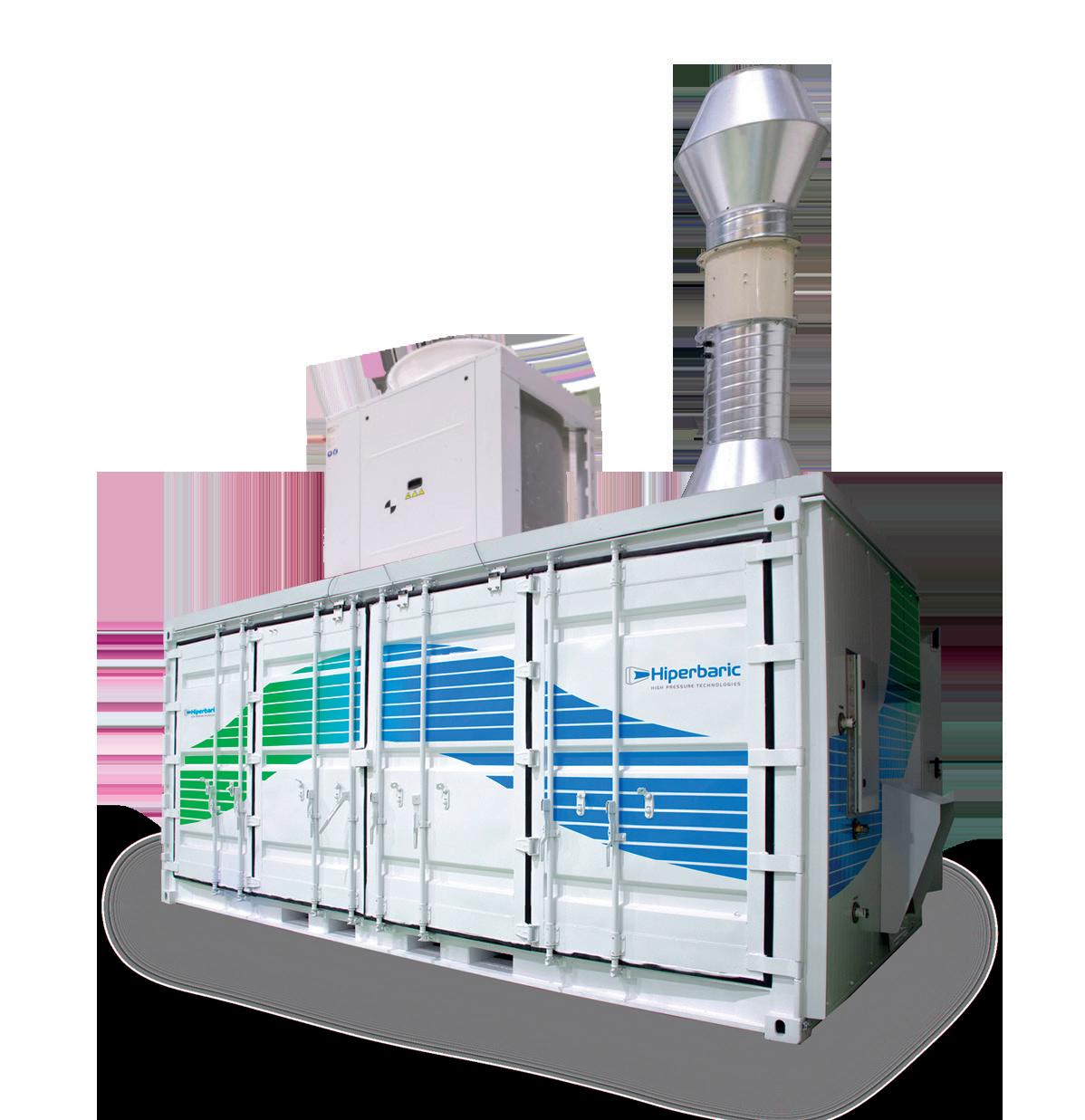
Modular and scalable design that can include one or two compressors
Aftersales service for installation and start-up, supply and manteinance







GLOBAL LEADER IN HIGH PRESSURE TECHNOLOGY www.hiperbaric.com
The energy transition is happening, driven by the twin requirements of the need to decarbonise and the need to ensure security of energy supply. This transition will involve a fundamental rethink of the global energy system, but some things will not change. In essence, energy will still have to be generated, transported and utilised. Currently this energy generation relies mainly on fossil fuels, with the primary energy sources being geological coal, oil and gas deposits. These hydrocarbons are then transported to their point of use and converted into a useable form, either through direct combustion (e.g. for space heating or transportation) or through conversion into electricity (e.g. in gas power stations). In the future, the end users of energy are likely to remain the same (the laws of physics dictate that steelmaking is an energy-intensive process), but the primary sources and the medium of transport of this energy will change. The need to decarbonise means that renewable or low-carbon energy sources will become more important, so future primary energy sources are likely to be in areas where solar, wind or tidal power is plentiful. These areas have already been identified, and include the likes of North Africa or Australia for solar power, or the North Sea for wind power. Importantly, these primary sources of energy tend to be physically separate from population
and demand centres. Consequently, there is a need to store and transport this energy in a similar way to how this is currently being achieved. Various studies have been carried out that look at the most economic way to achieve this. However, without a step change in technology, it appears inevitable that the best way to transport large volumes of energy over medium to large distances (intra- to inter-continental) is via a molecular medium – primarily gaseous hydrogen – in a pipeline.
In short, it makes sense to use offshore wind or North African solar power to generate hydrogen and to use this hydrogen to power German industry – rather than trying to locally generate or undergo a full-scale electrification of industry and reconstruction of the electricity grid. Therefore, pipelines are central to the future energy ecosystem (see Figure 1).
Integrity management of hydrogen pipelines
Future hydrogen pipelines are likely to be a mix of new-build and repurposed existing hydrocarbon pipelines. The exact mix will be driven by the particular distribution of supply and demand over the next decades. However, economic reality dictates that repurposing will take place where possible. This is reflected in the proposed

46
Neil Gallon, ROSEN UK, and Jens Voss, ROSEN Germany, discuss the importance of pipelines in the energy transition, and the management required to ensure their safe operation with hydrogen.
European Hydrogen Backbone, which envisages that 60 �70% of the future hydrogen network will be repurposed existing pipelines. Regardless of the mix, a robust integrity management strategy for these future hydrogen pipelines will be required. The integrity management of hydrogen pipelines is not a new concept – there are already approximately 4500 km of hydrogen pipelines in safe operation around the world and the principles underlying any successful integrity management system are fluid-independent. Despite this, hydrogen is not the same as natural gas, and the threats associated with a hydrogen pipeline are not the same as those associated with a natural gas pipeline. The integrity management systems of these proposed future hydrogen pipelines must recognise and take account of this. The integrity threats associated with hydrogen pipelines can be split into two major types. Firstly, there are threats which are independent of the fluid transported, and secondly, threats that are either introduced or exacerbated by hydrogen. Examples of the first type include external corrosion or ground movement, i.e. threats that are already considered and managed through existing pipeline integrity management systems.

This article will focus on the second category: the threats that are hydrogen specific. These threats are mainly associated with the potential for hydrogen embrittlement and associated effects on mechanical properties. In broad terms, hydrogen embrittlement will decrease fracture toughness, increase fatigue crack growth rate and decrease ductility (as defined by elongation until failure). The effects of hydrogen embrittlement on strength (both yield and tensile), are less clear, but the consensus is that they are not significant under typical pipeline conditions. These effects mean that cracking, and in particular, fatigue crack growth, is likely to be a more severe threat to a hydrogen pipeline than to a hydrocarbon pipeline.
A sound integrity management plan relies upon an accurate quantified assessment of this threat to enable appropriate mitigation measures to be put in place. Quantification of a cracking threat requires accurate sizing of any crack-like defects which may be present, knowledge of the loading (cyclic and static, longitudinal and hoop), and an understanding of the material properties (primarily fracture toughness in both air and hydrogen) associated with the crack-like defects. For a new-build pipeline,
47
these can be controlled through appropriate design, material selection and production testing (including NDT). However, for repurposed pipelines, the available data is often incomplete. Some measures which are easy to implement at the design stage for a new-build pipeline, (choice of wall thickness or material selection) are effectively impossible for a repurposed pipeline. Therefore, the challenge in terms of repurposing is to accurately characterise the existing pipeline and correctly assess it for its new duty.

Data collection and diagnostics
Regulators and industry groups are working collaboratively to develop protocols and standards to assist in the safe repurposing of oil and gas pipelines. Repurposing activities will be the focus of the industry for a large amount of existing pipelines of different ages, diameters, material characteristics and anomaly populations included. Standards including ASME B31.12 support these activities and demand an in-depth understanding of the asset itself. Assessment of construction records and material certification, and testing for future fuel
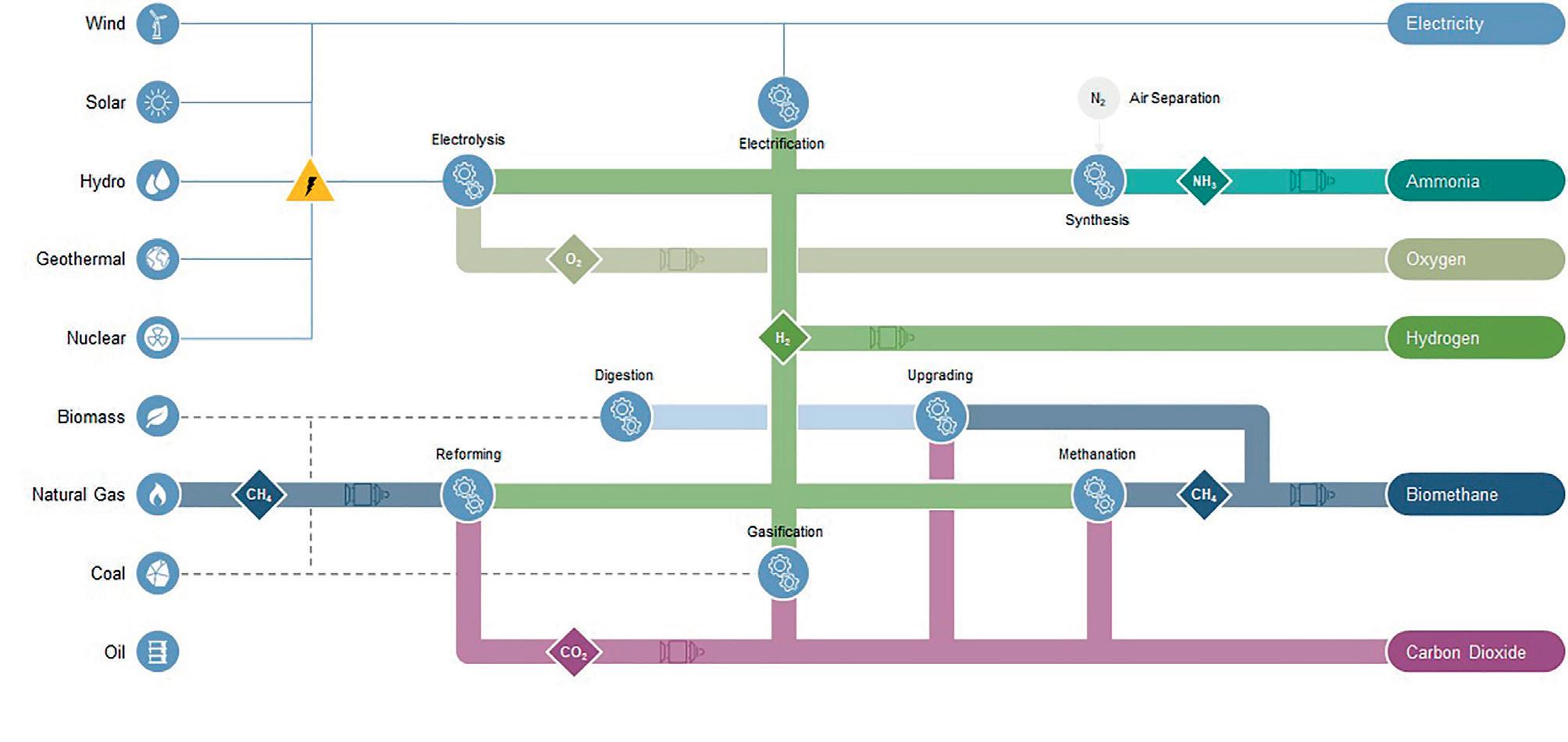
operations, as well as updated threat assessments, are only a fraction of the efforts that need to be executed for a successful and cost effective transformation process.
Besides methods including pressure testing and direct assessments, in-line inspection (ILI) technology can be of significant value in repurposing activities. The support of integrity decisions with measurement data has improved over the last decades, and technological developments in other industries (telecommunication, defence, IT, etc.) will further enhance capabilities. In-line inspection tools can be classified by integrity threat type or technology principle. Widely used principles include mechanical calipers, magnetics, eddy current, ultrasound or electromagnetic acoustics. By having knowledge of the integrity threats for pipelines transporting hydrogen or other future fuels, it can be recognised that different kinds of ILI technologies can support integrity management plans. Those technologies could be for the detection of deformations, mapping or corrosion, or particularly applicable to future fuels – for example, the determination of material properties or the detection of cracks and crack-like anomalies in gas pipelines.
An in-line inspection diagnostic portfolio delivers solutions from simple cleaning applications, to high-resolution crack detection services in order to understand feature populations and deliver data for integrity management decisions. It is important that all of these applications are also available in future fuel assets to properly prepare the pipeline for inspection with cleaning solutions and to be able to perform high resolution diagnostic services. Table 1 summarises the applications and technologies available. First inspections in smaller diameter product lines for hydrogen, ammonia and carbon dioxide (CO2) have already been conducted. The use of the solutions in larger diameters, and for longer pipelines, are under development.
Structural integrity decisions require in depth understanding of defect population, material utilised, as well as loading
48 Autumn 2023 GlobalHydrogenReview.com
Figure 1. Schematic showing the central role of pipelines.
Figure 2. The EMAT technology is a validated ILI technology for the detection of crack-like features in gas pipelines.
applied on the asset. Two technologies from Table 1 are of particularly high value during repurposing activities from gas pipeline to hydrogen. The material properties service, RoMat PGS, can be used to establish one pipe grade reference value per pipe joint with use of in-line inspection. Furthermore, the RoCD EMAT-C service can be utilised in natural gas pipelines to assist in the management of stress-corrosion cracking and long seam integrity. It also holds a significant advantage over conventional ultrasound as it does not require a liquid couplant. This means that it can be applied in a gas line without the need for liquid batching. There are several generations of inspection tools available and the latest implementations show signification improvements in circumferential resolution and sensitivity. The technology allows for the detection, identification and sizing of axial planar flaws.
An example of the application of this approach for a real pipeline is shown in Figure 2. In this case, a pipeline was inspected with both ROSEN’s EMAT technology (to characterise any crack-like features present) and PGS technology (to identify material populations present).
Figure 3 provides a graphical representation of the different material populations present in an approximately 210 000 ft / 64 km long pipeline, with each marker representing an individual pipe joint (normally ~ 12 m long). In this case it can be seen that approximately the first 65 000 ft of the pipeline is identifiably different from the remainder, being of a different wall thickness (0.25 in. / 6.35 mm), as well as a subtly different strength. The crack detection tool identified four crack-like indications, shown as the black diamonds. All of these indications were present in the first section of the pipeline, and therefore should be assessed using the loading and material properties associated with this section. Although ILI cannot yet accurately measure hydrogen affected material properties, the use of a material properties ILI technology, such as RoMat PGS, can allow accurate targeting for the purposes of sampling and destructive tests. These tests can be undertaken in dedicated hydrogen laboratories, such as ROSEN’s new facility in Lingen, Germany (see Figure 4). This targeted approach is both lower in cost and more accurate than the code-standard approach of destructively testing at a rate of 1 dig per mile, allowing for a more accurate assessment of both the likelihood of fracture and the remaining fatigue life of any features identified.

Pipelines are here to stay
In conclusion, the energy transition is in full flow and it appears inevitable that hydrogen will play a key role. This
Application Technology principles
Cleaning Mechanical scrapers, brushes
Deformation/ movement Calipers, eddy current, gyroscope
Metal loss Magnetic flux leakage, eddy current, ultrasound
Material properties Magnetic flux, eddy current
Cracking Ultrasound, electromagnetic acoustic transducer, eddy current
means that pipelines will remain central to the future energy supply chain. These pipelines will be a mixture of new-build and repurposed existing pipelines, both of which will require management to ensure their continued safe operation. The principles of integrity management of hydrogen pipelines are the same as those for any other pipelines: they rely on a quantified understanding of potential threats and an accurate assessment of the magnitude of these threats. These principles require accurate input data, derived from inspection and material testing, and appropriate assessment. With this approach, the energy transition can be successful.
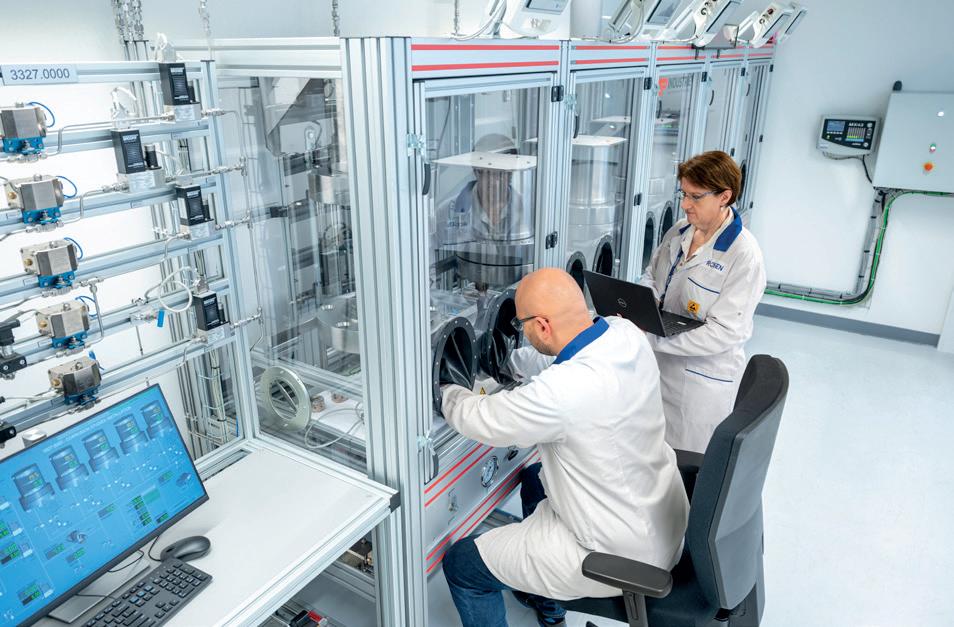
Autumn 2023 49 GlobalHydrogenReview.com
Table 1. Applications and technologies
Figure 3. Combining the EMAT and PGS ILI data allows for a variety of insights for integrity management decision-support.
Figure 4. ROSEN opened the dedicated hydrogen laboratory in early 2022.
In just a few short years, low-carbon hydrogen – produced using electricity from renewable sources such as wind and solar photovoltaic (PV) – has gone from being something of a niche industry sector to a key weapon in the fight to limit global temperature rise to 1.5°C this century, in line with the 2015 Paris Agreement.
This is because the process of electrolysis used to produce hydrogen, whereby an electrical charge is deployed to split water into its constituent elements of hydrogen and oxygen, produces oxygen rather than fossil fuel-led emissions such as carbon dioxide (CO2) and greenhouse gases (GHGs).
Another source of promising news is that as renewable energy from wind, solar and other alternatives to fossil fuel sources becomes more abundant and affordable, the production of green hydrogen for commercial or industrial usage becomes more cost effective.
Dr. Sleman Saliba, ABB Energy Industries, Germany, explores how automation technologies can help green hydrogen to fulfil its potential as a driver of decarbonisation.
Therefore, green hydrogen has the potential to decarbonise energy-intensive, hard-to-abate sectors, including power generation, heavy industry and transport. Hydrogen can also be processed one step further by adding nitrogen to create liquid ammonia, which can hold a significantly larger amount of energy, making it ideal for use in shipping, which accounts for approximately 2% of global energy-related CO2 emissions.¹
This article will discuss how the hurdles around energy intensity, cost and scalability can be overcome. The reasons why collaboration, strategic partnerships and knowledge-sharing is essential to drive scale will also be explored.

A question of cost
For hydrogen to fulfil its undoubted potential and make the leap from its current primary use as a GHG emissions enabler
50
(blue, grey, brown or black), to a driver of decarbonisation across hard-to-abate industries (green), it must achieve parity with other processes in terms of cost.
A 2022 report from Bloomberg Intelligence confirms that production costs are a significant barrier to the adoption of hydrogen. The costs of green (or zero-carbon) hydrogen are two-to-three times more than blue hydrogen, meaning that renewable energy and electrolyser capacity must expand rapidly through technology development and building scale.² In a best-case scenario – one that assumes low-cost renewable electricity at US$20/MWh and scaled-up electrolyser production – the International Renewable Energy Agency (IRENA) predicts that green hydrogen could be competitive by 2030.
The report goes on to state that the production cost of green hydrogen in 2022 was between approximately
US$4 – US$6/kg. This is three-to-four times higher than the production cost of grey hydrogen. Therefore, the economic case for green hydrogen produced via electrolysers rests first on lower costs for renewable energy, which is the largest expense.
More than 70% of the total operating costs to make 1 kg of hydrogen come from the cost of the electricity that is used to split the water molecule in the electrolysis process.³ Consequently, it must be an industry priority to drive these costs down and enable green hydrogen to scale up to the required GW levels.
A promising point is that wind power costs have fallen by 40% in the past decade and are set to fall even further. Electrolysers, the next largest expense, may be reduced through performance enhancements, manufacturing scale and other actions, which the IRENA predicts could cut costs by

51
as much as 80%. If this is achieved, green hydrogen could fall below US$2/kg by 2030 vs US$1 – 2/kg for grey hydrogen. The current high price of gas has also reduced the cost differential between blue and green hydrogen.
The transformative role of technology
Sustainable hydrogen production is energy intensive and, therefore, successful operation of a hydrogen plant must be centred around efficient energy and process management, as well as minimising OPEX.
ABB is committed to delivering the aforementioned performance enhancements and to using technology innovation to drive down the cost of producing low or zero-carbon hydrogen. The company recognises that the energy sector is moving away from a linear approach − which saw utilities produce and deliver energy downstream to consumers − towards a more synergistic and integrated ecosystem, one where production and consumption collaborate.
Automation and digital technologies offer hydrogen plants unprecedented visualisation and control of the production cycle, allowing them to monitor and optimise key processes, identify and eradicate inefficiencies, reduce downtime and employ data acquisition and analytics for more informed decision making.
ABB Ability™ Energy Management and Optimisation (OPTIMAX) for green hydrogen strategically directs energy flows and assets to ensure that industrial processes operate in the most energy efficient way possible, whilst increasing reliability and safety, and reducing OPEX.
Increasing plant efficiency
OPTIMAX supports the predictive optimisation of electrolysers, a fundamental part of green hydrogen production, based on demand schedules, and/or renewable energy production and/or market schedules during operation. It also facilitates real-time control of single electrolyser modules based on individual efficiency curves and security constraints. This ensures that monitoring of electrical energy, heat and mass flows across the whole process takes place, and that power is distributed in an optimal way.
OPTIMAX includes a predictive intraday optimisation tool that enables operators to identify potential flexibilities, which can then be positioned more efficiently. For example, during a project’s conceptual design phase and feasibility study, customers use predictive optimisation simulations to check
profitability when adding options such as hydrogen storage or enabling sector coupling reusing waste heat.
To summarise, this helps operators to optimise asset performance; simulate and virtualise the most productive energy flows and use adaptive control to achieve them; and forecast energy demand and supply, including renewable energy.
Case studies
This section will detail a couple of examples of where ABB’s green hydrogen solution could be deployed.
A utility looking to make better use of excess renewable power rather than selling it at lower prices could use the technology to optimally orchestrate energy flows based on renewable generation and downstream demand, in addition to using a hydrogen plant to convert the excess wind power or solar power into hydrogen. Downstream consumers, such as industrial plants, heavy industry and hydrogen fuel stations can consume the produced hydrogen. Therefore, the utility is able to leverage excess renewable power, selling it for the optimal price, at the optimal time.
ABB’s solution can also help industrial plants to decarbonise processes and replace grey hydrogen with green hydrogen in order to exploit and avoid peak times and prices. The solution can be deployed to monitor, control and optimise multiple individual electrolyser modules at a plant. The facility can balance available energy sources to ensure availability, while leveraging optimal market pricing. As a result, the plant’s OPEX life cycle cost can be reduced by up to 20%.
Industry collaboration
Collaboration and knowledge sharing can create an ecosystem of industry and thought leaders. The overlapping of expertise and solutions can help to scale up technologies and reduce the cost of building green hydrogen assets.³
An example of this is ABB’s agreement with Hynamics, the hydrogen subsidiary of EDF Group, to optimise production costs by integrating OPTIMAX at Hynamics’ ‘AuxHYGen’ low-carbon hydrogen production and distribution station in Auxerre, France.
Optimising electrical costs is achieved by improving the performance of the electrolyser process, supported by simulation at the design and engineering phases and real-time monitoring of energy use in operation. The tool considers electricity price variability and asset availability among other factors.4

52 Autumn 2023 GlobalHydrogenReview.com
Figure 1. Hydrogen station for the urban community, supporting a local bus network.
SouthH2Port project
ABB’s portfolio of green hydrogen projects also includes a collaboration with Lhyfe and Skyborn on SoutH2Port. When fully operational, SoutH2Port is expected to produce around 240 tpd of hydrogen, with an installed capacity of 600 MW.
Powered by Skyborn’s planned 1 GW offshore wind farm, the plant in Söderhamn, Sweden, will produce the equivalent of approximately 1.8 million bbl/yr of oil. ABB is optimising the integration of the hydrogen and electricity production, including automation, electrical and digital technologies, as well as driving development of commercial energy transition projects in and around the region.
ABB aims to explore opportunities to tie-in power-to-X conversion technologies, turning renewably-sourced electricity into carbon-neutral energy carriers, such as hydrogen, and storing the energy for later use. SoutH2Port will support the decarbonisation of the Swedish energy system, either directly with hydrogen supply, or by further downstream production of refined fuels such as methanol, ammonia or sustainable aviation fuel (SAF).
Conclusion
The energy landscape is undoubtedly changing with the accelerated need for decarbonisation, and hydrogen is playing a vital role in this transformation. However, multiple hurdles that are currently preventing the widespread uptake of low-carbon hydrogen as an alternative to fossil fuels need to be overcome.
These include the prohibitive cost of low-carbon hydrogen production, primarily renewable energy costs related to
operating electrolysers. For green hydrogen to achieve GW-scale, clean energy and electrolyser capacity must expand through technology development and building scale.

Investment must also be matched by political will, legislation and widespread industry collaboration, incentivising the expansion and optimisation of green hydrogen research and production.
Digital, automation and electrification technologies will play a vital role in helping energy producers and industrial plants coordinate assets, generation and production to optimise the total value of energy. When deployed properly, the power of an energy management and optimisation system is revealed, combining monitoring, control and optimisation with other energy innovations such as steam power and district heating.
References
1. ‘International Shipping Analysis’, IEA, https://www.iea.org/energysystem/transport/international-shipping.
2. ‘Clean, versatile hydrogen emerges as key decarbonisation vector’, Bloomberg Intelligence, (18 July 2022), https://www.bloomberg. com/professional/blog/clean-versatile-hydrogen-emerges-askey-decarbonization-vector/#:~:text=Clean%2C%20versatile%20 hydrogen%20emerges%20as%20key%20decarbonization%20vector,-Bloomberg%20Intelligence%20July.
3. ROCHE, B., ‘Collaborating and innovating to fast-track and standardise the production of low-carbon hydrogen’, ABB, https:// new.abb.com/process-automation/energy-industries/hydrogen.
4. ‘ABB and Hynamics collaborate to lower hydrogen production cost’, ABB, (1 February 2023), https://new.abb.com/news/ detail/99316/abb-and-hynamics-collaborate-to-lower-hydrogenproduction-cost#:~:text=Hynamics%20has%20signed%20an%20 agreement,percent%2C%20according%20to%20ABB%20modelling
Global Hydrogen Review Online
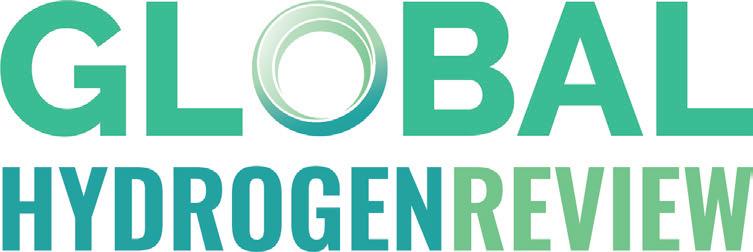
Visit our website today: www.globalhydrogenreview.com Home to the latest hydrogen news, analysis and events

54
Public desire for increased sustainability has had a massive impact on process operations, particularly in the fuel manufacturing and energy generation sectors. One of the first ripples has been a shift of focus to new energy resources, including the spectrum of varying hydrogen technologies, classified by colour, with green hydrogen being the most eco-friendly option. This shift has created a new energy value chain with massive potential, but only for the producers and providers who can successfully navigate the full value of the hydrogen process from end-to-end.
The value chain for green hydrogen generation and consumption is complex. To manufacture green hydrogen, organisations must harness renewable energy from solar, wind, hydroelectric, and other sustainable power sources. This green hydrogen must then be transported and stored, requiring precise operations and the right containment systems. Finally, stored hydrogen must be distributed to an end user or industrial process, such as a power generation plant with hydrogen-capable turbines, where it is used to produce electricity.
Because this value chain is not yet proven, it comes with great risk, but there are potentially great rewards. Yet, even with all of the unknowns, innovators can build a robust foundation for the best outcomes when navigating this new arena of green energy opportunity, while significantly reducing risk, by employing the following essential strategies:
y Implementing an open, unified control platform across the value chain.
y Leveraging the data from a unified platform in powerful, high-fidelity simulation tools.
y Taking advantage of comprehensive guidance from industry automation experts.
These strategies will help companies to build, refine, and scale end-to-end green hydrogen solutions more quickly and successfully in order to drive increased return on investment (ROI) and capture competitive advantage (Figure 1).

55
Successfully navigating the bold adventure of a new green hydrogen value chain means starting with a strategic vision of a unified automation ecosystem. Lauren Wherry, Emerson, USA, discusses how this can be achieved.
Utilise a single, cohesive, open control platform
Building and maintaining a facility or fleet based on new technologies is complicated, but basing the end-to-end technology on a wide variety of different platforms dramatically increases that complexity. In fact, the complexity resonates across a wide array of areas, including engineering and design of processes, operations, training, innovation and scalability, and more. Multiple different systems must be connected, which typically require multiple engineered interfaces. When anything needs to change, those interfaces must be updated or re-engineered to ensure that there are no problems in data conversion.
In contrast, implementing a single, common solution across the entire value chain creates a platform for operational efficiency. First and foremost, the best automation platforms are built with native communication and validation of connectivity. With this type of architecture, multiple control systems across different facilities can communicate with devices and each other, with no need for custom-engineered interfaces.
Power to the operator
A single control platform provides increased ease of use as all systems across the value chain have the same historical retrieval process for data capture, making it easy to trend and analyse data for improved operations. Moreover, trip reporting, alarm reporting, and root cause analysis are all presented in a unified format and come from the same system, increasing operational awareness. This standardisation of data provides operators with a consistent and cohesive interface, helping them to isolate critical information more quickly to make better, safer decisions. Operators only need to be trained on a single interface to be effective anywhere in the value chain (see Figure 2).
For example, when operators perform complicated tasks, such as start-up and shutdown or reacting to a process excursion, the value of a simple, cohesive interface cannot be understated. Having every tool at their fingertips and being
familiar with each of them means that operators in stressful situations can trust what they see on their screen, whether it is alarms, reports, or diagnostics. That trust makes it easier for the operator to identify trips quickly, isolate why they happened, and understand how they can recover. In situations where seconds count, operator familiarity with an intuitive system makes all the difference.
Moreover, when issues arise that operators cannot diagnose, and technical experts are not onsite, having a native, read-only duplicate of real-time data can be invaluable. Using the same, familiar software for controls, alarms and trends minimises operations and maintenance costs by taking full advantage of remote troubleshooting, saving commutes to sites and leveraging multiple resources.
Reliable automated control
Applying a single, open, unified control system not only eases operation, but also sets the stage for implementation of higher-level automation. Integration across a unified control system makes it easier to implement technologies like advanced process control (APC), allowing the system to quickly make choices to reduce the need for operator intervention, helping eliminate human error. In addition, in critical situations, APC can intervene to stabilise processes before an operator would even be able to identify an issue.
For example, predictive analytics can determine normal operating states of process equipment and recognise abnormal states. Using model-based technologies, historical data can be used to build models and apply bias, allowing processes to be run in the most efficient manner to optimise operation, and to easily identify when a process exceeds a predefined tolerance.
The most advanced systems also offer optional plug-in applications to extend the base control framework, enabling higher-level analysis of plant conditions. These plug-ins are developed using a combination of neural networks, model-based control, dynamic prediction, applied intelligence, or other analytic technologies.

In the event of an impending process upset or equipment failure, the framework’s expert system, along with any advanced functions provided by control system plug-ins, alert and guide operators to take immediate, specific action, or to interact directly with the control system to resolve the situation more quickly and effectively.
Safer and more secure
Native connectivity also increases safety and cybersecurity. Safety instrumented systems built on the same platform, as well as purpose-built cybersecurity solutions, can also be seamlessly integrated into the control architecture, helping to ensure the safest possible operations. With no custom-engineered interfaces between different elements of control, teams naturally reduce attack vectors and
56 Autumn 2023 GlobalHydrogenReview.com
Figure 1. Implementing a single, integrated automation solution that looks and works the same, from green hydrogen production and storage to hydrogen-fuelled power generation, creates a platform for operational efficiency.

limit the required scope of defence-in-depth solutions, driving more secure operation.
Value across the chain
If all control technologies across the value chain look and work the same from end-to-end, an entire hydrogen power operation is easier to manage. From the power plant side, the team might need to know what level of green hydrogen storage they have available so that they can adjust projected loads. If operators find that storage is low, the ability to know the state of the electrolysers in the manufacturing facility and their ability to ramp up production would be beneficial. Such interaction is significantly easier if the power generation personnel are using the same control system and interfaces as the hydrogen manufacturing facility.
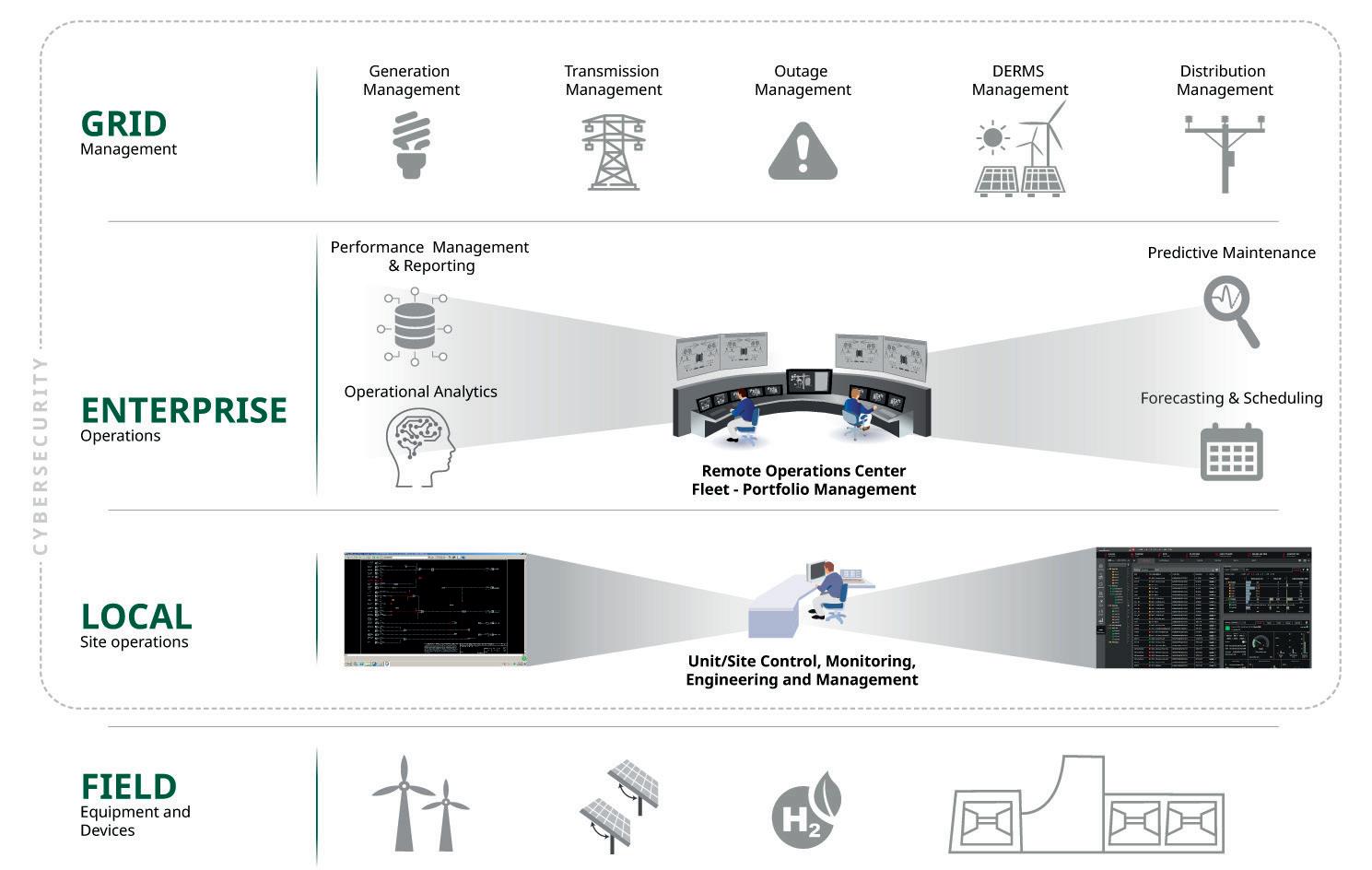
On the other hand, if hydrogen storage is full, personnel on the manufacturing side may need to see load projections from
the power plant and how many tonnes of hydrogen per hour will be consumed to help adjust operations. With everything on one platform, it is much easier to develop the programmes and procedures necessary to manage such adjustments.
Navigate change and uncertainty with simulation
The green hydrogen value chain from creation to power generation is still a work in progress. Most power generators operating hydrogen-capable turbines in the near future will not be using 100% hydrogen from the first days of operation. Instead, operations teams will start with a percentage of hydrogen blended with another fuel source and then gradually increase the percentage of hydrogen used, making improvements as they learn. They will also likely expand the number of electrolysers and other critical equipment that they use, scaling as operations prove successful. However, teams will not be able to accomplish this gradual improvement if they need to test and train exclusively on live systems, due to the associated outage time and safety risk.
Simulating strategy
The need to continuously evolve systems in a safe, non-invasive environment makes digital twin simulation an instrumental part of project success. A high-fidelity digital twin with embedded modelling from the control system empowers operators and engineers to test changes in a safe, simulated manner that exactly replicates their control environment. Using the same engineering tools as the control system, and the same interface they will see in the control room, users can change processes and equipment and see exactly how adjustments will impact their operations.
This type of digital twin enables operators to start with a small percentage of hydrogen and gradually increase the amount to see how the effects cascade across their production environment. Teams can save any system state to run tests on the identical environment in several different ways. And, if the digital twin is a highly accurate replica of the existing control system, when they have a solution that works, the team can easily copy the configuration over to the live system.
However, making changes to prove success on an increasingly larger scale is not the extent of the digital twin’s testing value. Operations teams can use simulation to test any number of uncommon processes or process aberrations. For example, the team might use the digital twin to run through start-up procedures, testing to ensure the controls respond as anticipated and that the team
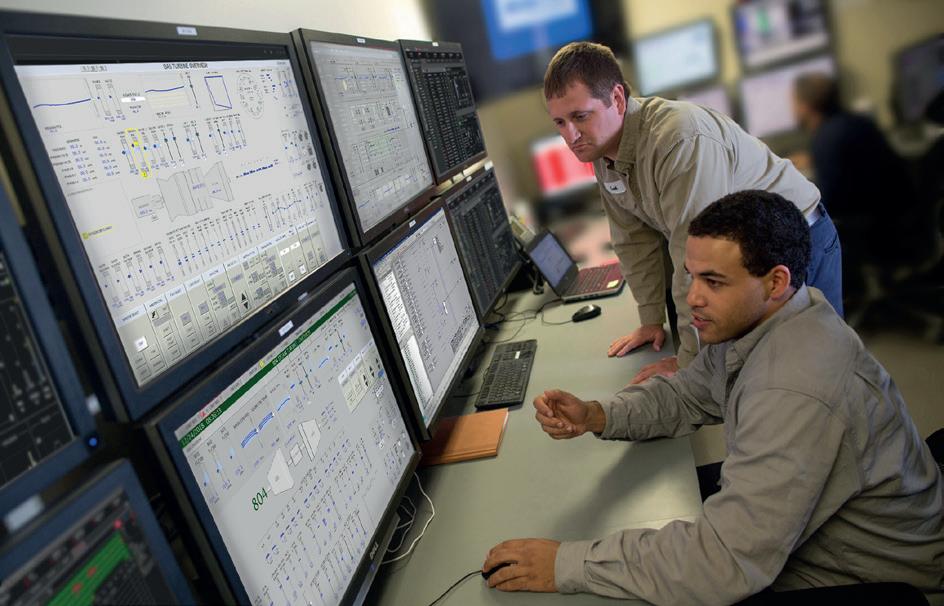
58 Autumn 2023 GlobalHydrogenReview.com
Figure 2. Providing a unified view of contextualised, real-time operational data improves situational awareness, helping operators to isolate critical information more quickly and make better, safer decisions.
Figure 3. The best automation solution providers offer systems that reduce complexity by making it easy to move information from end-to-end across the green hydrogen value chain, as well as from the field up to the enterprise and grid.
can keep the unit in a safe state. Teams can also make changes to the simulation state to test other events, such as trips, equipment changes, alarm effectiveness, and more.
Better training for immediate success
In addition, digital twin simulation is a powerful training tool. A trainer can manipulate the simulator into any state that they desire and then hand the simulation over to the operator, who manages the system using the same interface as in their day-to-day work. Because this training does not impact the live production environment, it can occur in tandem with operations or capital projects. At the end of any project – whether it is a small equipment change or a full facility build-out – plants know that operators will be prepared to perform at their best from the first moments of operation.
Standardisation for a more holistic operations experience
The value of choosing a single trusted automation supplier goes well beyond the control system. When operations teams also choose instrumentation and industrial software solutions from a trusted partner, they streamline data sharing, helping to build a boundless automation architecture, where democratised data moves seamlessly from the intelligent field, through the edge, and into the cloud.
Today’s smart instrumentation provides vast amounts of valuable data. For example, a smart valve can do much more than simply report its position to the control system. The best devices also provide a valve signature that helps teams to see
when the valve is starting to perform poorly. If that valve is designed to seamlessly integrate with the other technologies in the plant, the team can easily feed critical data, such as valve signatures, into other tools, namely device manager or machinery health software.
The best automation solution providers offer systems that make it easy to move information from the entire value chain up to the enterprise. Additionally, these systems typically offer integrated industrial software solutions to simplify the connection to the grid. A provider with hydrogen expertise and power industry experience can help organisations to design, implement, and maintain projects across the life cycle, with more ease (see Figure 3).
Further, working with a single, expert supplier means having a single point of contact when issues arise, which helps teams determine the root cause of problems much more quickly.
Capturing the future of energy
Entering uncharted territory such as the green hydrogen value chain comes with significant risks, but also high rewards. As with any adventure into the unknown, pre-planning to account for and offset risk is an essential step. Fortunately, many of the most critical risks of new hydrogen power projects can also be mitigated in the pre-planning stage by implementing a single, advanced, unified control platform across the chain, from end-to-end. The future of green energy is open to those bold enough to dive in, but competitive advantage and dramatic ROI will be reserved for those wise enough to strategise from the outset.
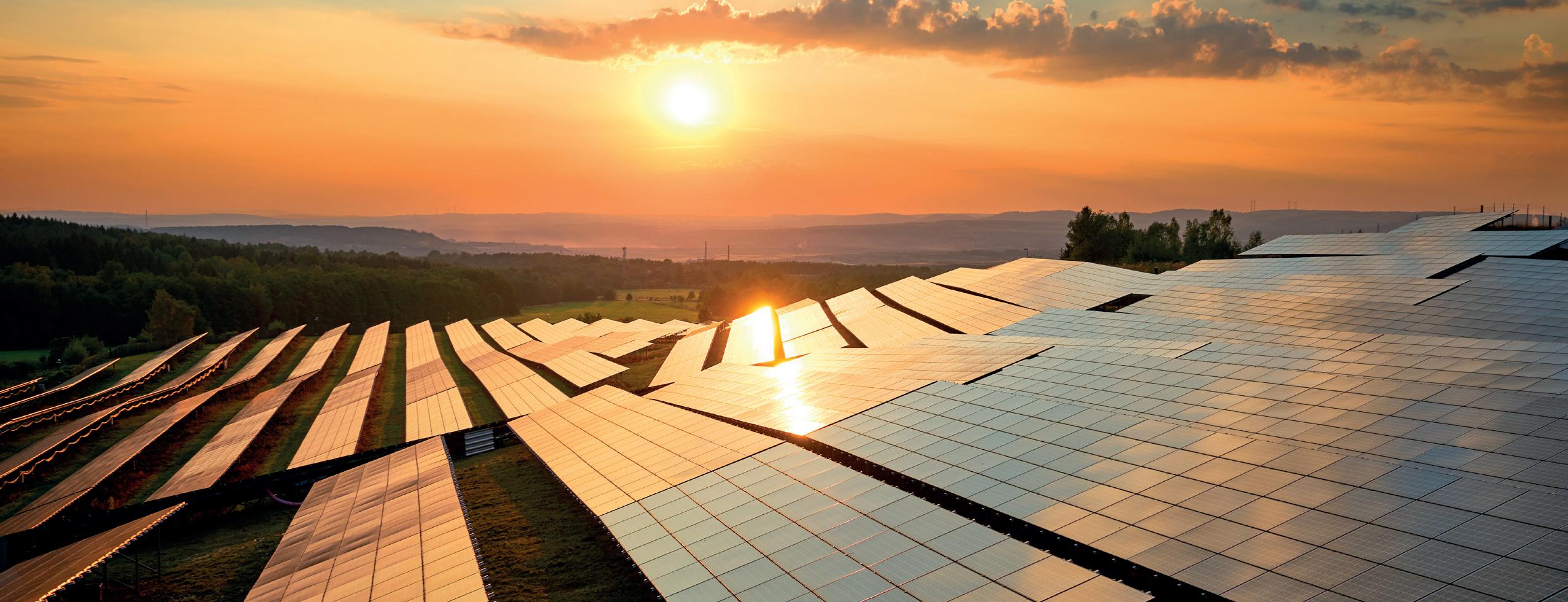
The premier source of information for the renewable energy industry Register for free at www.energyglobal.com

 Alessandro Piscioneri, Comau, Italy, explores how automation can accelerate the production of emission-free energy for use in mobility applications.
Alessandro Piscioneri, Comau, Italy, explores how automation can accelerate the production of emission-free energy for use in mobility applications.
It is widely recognised that electrification is a key factor in achieving the zero-impact decarbonisation targets set by the European Commission through its ‘Fit for 55’ legislative proposals, as well as the 2015 Paris Agreement. While ‘Fit for 55’ aims to reduce vehicle greenhouse gas (GHG) emissions by 55% by 2030 and 100% by 2050, the Paris Agreement aims to limit the global average temperature increase to less than 2°C.

However, to achieve these goals, the transformation of the world’s energy system must accelerate substantially. When trying to increase the production of safe and sustainable batteries, automation can play a key role in terms of increasing the production capacity of battery cells and ensuring better battery integrity and performance. Additionally, automation can also contribute to the disposal of new-generation batteries.
Manufacturers all over the world require support to juggle the multifaceted electrification industry, where they often have to balance key production requirements with the inherent uncertainties of an emerging market. From an engineering point of view, the automated production of lithium-ion cells, modules and battery packs is not dissimilar to other high-end assembly processes. However, the underlying complexity of a battery production system requires the identification and optimal combination of processes and technologies for the specific nature of each battery design and project.
Reporting in July 2022, the International Energy Agency (IEA) stated that global demand for batteries for electric mobility will grow five to nine times in 2030 compared to 2021. Based on internal estimates from various market sources, Comau predicts that high-energy lithium-ion batteries will lead the way in powering a wide range of mobile and stationary applications. A new generation of solid-state batteries is being developed simultaneously. Unlike current lithium-ion technology, which is based on liquid electrolytes, solid-state batteries are based on solid electrolytes and promise improved performance, offering several advantages in terms of energy density, safety (no risk of explosion or fire), longer life and charging efficiency.
Another important element in the context of e-mobility whereby automation can make a difference is the production of hydrogen. As a safe and highly-efficient energy carrier, hydrogen is in an ideal position to boost the adoption of renewables worldwide. The reliable, zero-emission power source can fuel passenger cars, light buses, city buses, road buses, trucks, locomotives, forklifts, trailers and many other applications. Hydrogen fuel cell technologies can also be extended to distributed power generation and cogeneration, as well as ships, aviation and other non-automotive sectors.
In addition to acting as a cost-effective energy storage and transport solution, hydrogen offers an effective way to reduce carbon emissions for sectors such as long-haul transport, chemicals, and iron and steel, in which other clean feedstock alternatives do not currently exist.
Unfortunately, the assembly and production of electrolysers and fuel cells tends to be slow, expensive, and labour-intensive. From a technical point of view, electrolysers enable the production of green hydrogen for applications in mobility and other sectors, whereas fuel cells generate electricity from hydrogen, and will be primarily used for mobility. To help mobilise the increased production and deployment of these technologies, Comau is working to industrialise manufacturing by developing a proprietary portfolio of solutions that can automate the main production steps, including cell preparation, stacking, compression, welding, leak testing and more. This will allow energy providers to scale up production volumes while increasing the quality of the high-precision process. It will also help lower the production costs by up to 20%, according to internal estimates.
The central role of automation
Automation is important for several reasons despite the relatively low volume of fuel cells compared to batteries (internal projections show that the global demand for fuel cells should reach 200 000 units in 2026, whereas a new gigafactory in Germany – to provide a concrete example � is capable of producing battery packs for more than 500 000 vehicles annually). The first reason is related to the
61
architecture of a fuel cell. The core, known as the fuel cell stack, consists of hundreds of repeated elements (100 � 300 cells per stack), whereas the cells themselves are composed of several layers – from two to four per cell, based on experience to date. Such intrinsic repetition is a key enabler for automation, as it leads to cycle times of 1 � 10 sec. per layer (depending on the product and plant productivity) during which each layer is picked, quality-checked and properly placed in the stack.
The high levels of precision and quality that are required during the assembly process is another reason why automation can help improve fuel cell manufacturing. First of all, each cell must be aligned within a tolerance of 0.1 mm and each component and layer is quality checked for surface and geometrical defects. Most manufacturers require full process traceability and until a stack has been sealed, many fuel cells necessitate adherence to clean room standards. Furthermore, fuel cell testing procedures are quite extensive, as they have to cover both leaks and electrical operations, with some of the leak tests performed at high speeds.
Automation is not limited to the robotisation of the assembly process itself, however. Digitalisation also plays a crucial role, as the storing of information at each step of the process (quality gates, visual inspections, field parameters) is vital to creating a database for detailed analytics. In this way, manufacturers can access the information they require to adjust the dynamics, refine the product, and potentially create a smarter, more efficient, and less complex assembly process.
Similar problems and opportunities are valid for electrolysers and, in many cases, the assembly process is largely analogous to that of fuel cells. Cycle time is less demanding, as volumes are much lower (according to internal estimates, the global production of electrolysers is expected to be 10 times less than fuel cells in 2026) but dimensions, weights and the number of layers per cell are much higher. An alkaline electrolyser, for example, can weigh more than 40 t, with cells measuring 1.5 m in diameter and composed of more layers than fuel cells.
Given that automation is relatively new in this sector, manufacturers must face multiple challenges, such as how to precisely handle and align floppy components (gaskets,

membranes, fabric and metallic meshes) at high speeds. To address these challenges, Comau has initiated several laboratory tests and customer collaborations in the field. The company is also applying many of the competencies and skills gained from delivering assembly lines for body-in-white, battery modules and battery packs, along with specific technologies such as laser and resistive welding, visual inspection, leak testing and high-speed assembly, to design its dedicated solutions.
A steadily growing market
According to the European Environment Agency, more than a quarter of the total carbon dioxide (CO2) emissions in Europe are emitted by the transport sector. The move toward fuel-efficient vehicles powered by renewable sources is a concrete way to reduce GHG emissions and move closer to the EU’s goal of total mobility decarbonisation. Achieving this objective will require increasingly advanced skills and constant technological innovation from the industry players contributing to the hydrogen value chain. Whilst it can be argued that automating what has traditionally been a manual manufacturing process is one of the biggest challenges for green hydrogen procurement, the careful management of the entire industrial process life cycle, from conceptual engineering to manufacturing and support services, is equally as important. Comau’s simultaneous engineering approach is key to helping its customers design products in a way that will be easier and more cost-effective when assembling them with automation.
In early 2022, Comau won a contract for its first hydrogen fuel cell project in China from Shanghai Hydrogen Propulsion Technology (SHPT), a subsidiary of SAIC Motor, to provide an advanced production line for a P4 hydrogen fuel cell stack. Featuring high-speed, high-precision multi-axis stacking technology, the solution simultaneously performs a series of pole piece stacking operations to manage the pick-up, code scanning, secondary positioning, and shell loading within 4 sec. Similarly, the company recently implemented a project in Europe, the Middle East and Africa (EMEA) that assembles fuel cells for light and commercial vehicles, and is collaborating with major manufacturers in various sectors and in other regions, to support their product development and industrialisation plans by providing consulting and technology services.
Based on internal estimates, Comau predicts that the market will grow exponentially, from a few thousand fuel cell units deployed in 2020, to 1.2 million units by 2030, equivalent to more than 100 GW of hydrogen energy.
To sustain such demand, two things will have to happen: the number of manufacturers will need to increase and cycle times will need to decrease. Indeed, some of the world’s most well-known manufacturers are already planning a tenfold increase in long-term productivity – from around 2 sec. per cell today to 0.2 sec. per cell in the future. However, to achieve this, automation will have to change significantly. If the current standard for building stacks is high-speed, low payload robots, the market will move toward accelerated processes and the first stacking machines (similar to the roll-to-roll equipment used in packaging, electronics and li-ion manufacturing) within five years or so. In all cases, the goal is the same: to speed up the production of reliable, emission-free energy and reduce the cost of manufacturing fuel
62 Autumn 2023 GlobalHydrogenReview.com
cells and electrolysers.
Figure 1. Flex BD, an example of Comau’s efforts to reduce emissions.
Clean hydrogen has the potential to be a major catalyst of decarbonisation. However, in order for it to succeed, the infrastructure that we use to make, move and use hydrogen needs to be exceptionally effective and efficient in order to achieve cost parity with alternative energy sources. The key to optimally-operating infrastructure is pairing a highly trained team with digital asset management, which increases efficiency and reliability, fortifies safety processes, and optimises operations and maintenance. These infrastructure enhancements result in a lower cost associated with the delivery of hydrogen – the driving factor in the transition to clean hydrogen.
See the forest and the trees: system-wide visibility
Digitisation of hydrogen infrastructure involves the integration of digital technologies and platforms to monitor, control and manage different assets and activities. The way in which this data is managed should be consistent throughout the entire hydrogen supply chain: from through production and storage, through to transportation and dispensing. The well-known saying of ‘you cannot improve what you do not measure’ holds true for hydrogen, and all journeys towards achieving asset optimisation start with asset visibility.

63
Richard Zhang, LIFTE H2, USA, explains why digitisation is key to developing the hydrogen industry.
When the management of the system is digitised and centrally visible, data analytics are swift and thorough, which enables operators to identify inefficiencies and streamline the process by optimising each asset’s performance. For example, a digital management system can monitor sensors in a hydrogen generation and export system, and create live equipment operation schedules based on the likelihood of asset failures, historical hydrogen usage patterns, local weather predictions, and grid energy prices.
Most asset inefficiencies stem from siloed data collection and lack of visibility into system-wide operations. By having a real-time view of the ‘forest’ and the ‘trees’, system operators can diagnose issues, identify potential impacts on other parts of the system, and find a resolution quickly, minimising downtime and maximising operational efficiency.
Maximise reliability
There is significant opportunity for hydrogen to replace fuel in the transportation, aviation and marine industries, among other sectors, but in order for it to solidify its place as a sustainable fuel alternative, it needs to be available when and where it is needed.
Most hydrogen assets that are currently on the market do not have historical data to support project financing, and tend to experience major performance issues every four to six months. Collecting sensor data as early as during factory acceptance tests; establishing performance baselines while accounting for every small change in the field; and recording all issues and incidents with cross-system data verification are critical considerations for optimising asset performance. The quality and quantity of the collected data and events determine the quality of the predictive maintenance programme, and any further development into artificial intelligence (AI) for a scalable system.
Enhance safety controls
Digitisation also reinforces the safety of hydrogen infrastructure. Managing hydrogen infrastructure involves strict compliance with safety regulations and guidelines. By using a digital platform, infrastructure operators can conduct real-time safety monitoring and ensure that all of the safety protocols are being followed. For instance, the digital platform can track the quality of hydrogen production over time and alert the operator when there is a deviation from the standard. This can help infrastructure operators avoid accidents and safety incidents; and maintain regulatory compliance and public trust.
Training and education of the hydrogen workforce is another key aspect of safety controls. As a nascent and growing industry, hydrogen is attracting workers from every type of specialty and could account for as many as 700 000 new jobs in the US by 2030. Large language models (LLMs) are AI systems that can process and understand human language. They are designed to have a deep understanding of how language functions. Integrating LLMs into training and operations of hydrogen infrastructure is essential in order to maximise safety by improving communication, comprehension and collaboration.
Especially when there is a workforce that may speak multiple native languages, LLMs ensure that nothing is lost in
translation, and enable diverse teams to tap into the historical archive of hydrogen incidents using their native languages. They can provide real-time translation of data, helping technicians to understand critical safety alerts, warnings and instructions in their own language. Comprehension is improved when LLMs provide context and explanation in a language that is easily understood by the technicians. This ensures that important hydrogen data is comprehended correctly and acted upon accordingly. The reduced barriers of accessing and consuming hydrogen knowledge will offer increased visibility and cross-pollination to hydrogen safety.
Streamline operations and maintenance
Asset managers need to be able to effortlessly monitor, assess and optimise hydrogen assets for peak performance. An intuitive and centralised platform allows managers to analyse productivity and gain actionable insights with ease; and can facilitate workflows including maintenance work orders, permits to work, and safety risk analyses. All of these elements of streamlining operations and maintenance efforts increase efficiency, and decrease operational costs. Paperwork orders and scribbled notes will be a thing of the past for service and safety technicians, replaced by real-time updates from handheld devices where cumulative and specific maintenance history and parts inventories are readily available and accessible, at any time. Streamlined operations and maintenance also unlocks worker efficiency, which helps in the quest to scale up hydrogen deployments. As the demand for hydrogen assets is outgrowing the supply of well-trained and experienced hydrogen operations and maintenance engineers, digitalisation can reduce the daily inefficiencies of paperwork and empower engineers to focus on meaningful work.
Conclusion
Digital asset management has become an essential aspect of hydrogen infrastructure development.
We are not only in a transition away from fossil fuels, we are completely shifting the paradigm of how we think about and manage energy infrastructure. The infrastructure of tomorrow will be optimised for safety, security and reliability, and it is important to invest in the fabric that will weave each piece of the system together.
Hydrogen systems, that are in the process of being deployed, need to be equipped with tools to optimise performance, prevent downtime, predict market and service needs, and efficiently manage operations and maintenance – and digital asset management is one solution. As the world embarks on this next era of energy infrastructure, LIFTE H2’s portfolio of digital tools can be used to secure future success and sustainable asset performance, which will enable clean hydrogen to reach its potential as a low-carbon energy source.
Note
Some of the content in this article was generated by ChatGPT under the guidance and direction of LIFTE H2 staff. The author of this article believes that AI should be seriously considered for its efficiency benefits when discussing digital management of infrastructure. Involving ChatGPT in the writing of this article was deliberate, as the aim was to illustrate how AI can play a role in elevating thoughtful discussion, as well as serve as an effective layer of digital asset management.
64 Autumn 2023 GlobalHydrogenReview.com
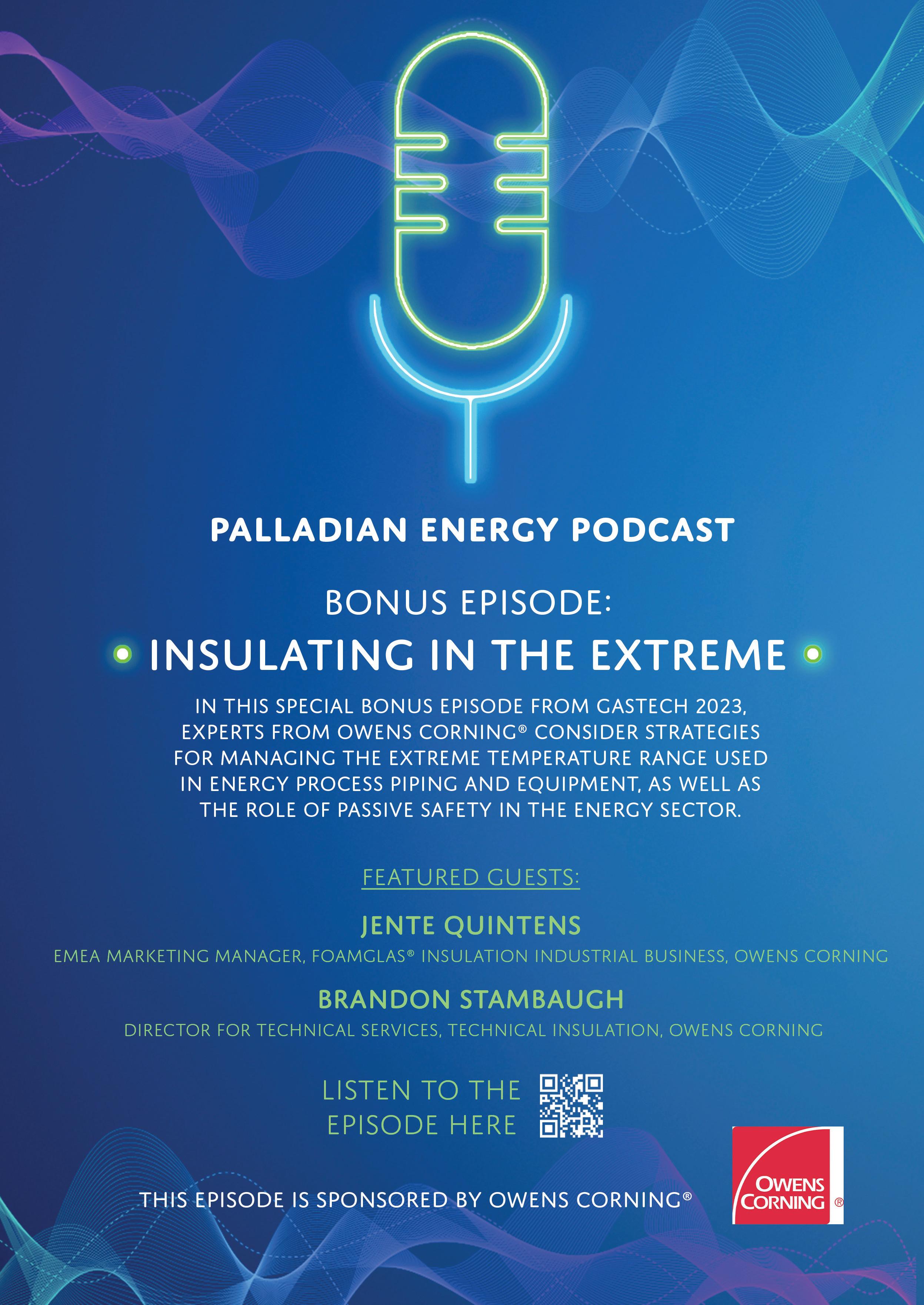
Chevron acquires majority stake in Advanced Clean Energy Storage Hydrogen Project
Chevron has announced that it has closed a transaction with Haddington Ventures to acquire 100% of Magnum Development LLC and a majority interest in ACES Delta, a joint venture (JV) between Mitsubishi Power and Magnum Development. ACES Delta is developing the Advanced Clean Energy Storage Project in Delta, Utah, US.
The Advanced Clean Energy Storage Project plans to use electrolysis to convert renewable energy into hydrogen and will utilise solution-mined salt caverns for seasonal, dispatchable storage of the energy. The first project, designed to convert and store up to 100 tpd of hydrogen, is under construction and is expected to enter commercial-scale operations in mid-2025 to support the Intermountain Power Project’s ‘IPP Renewed’ initiative. Several other opportunities for the project to produce and supply hydrogen to customers in the utility, transportation and industrial sectors in the western region of the US are in development.
First piloted flight of liquid hydrogen-powered electric aircraft
H2FLY, a wholly-owned subsidiary of Joby Aviation, has announced the successful completion of the world’s first piloted flight of a liquid hydrogen-powered electric aircraft.
The company completed a series of piloted flights with its HY4 demonstrator aircraft, including one that lasted more than three hours, fitted with a hydrogen-electric fuel cell propulsion system and liquid hydrogen that powered it for the entire flight.
The flights demonstrate the viability of using cryogenically-stored liquid hydrogen instead of gaseous hydrogen, which enables significantly lower tank weights and volume, leading to longer range. The successful installation and demonstration of flight with liquid hydrogen is believed to increase the range of H2FLY’s HY4 demonstrator aircraft from 750 km to 1500 km, marking a critical step towards the long-term decarbonisation of mid- to long-range aviation.
The successful flights are the culmination of Project HEAVEN, a European-government-supported consortium assembled to demonstrate the feasibility of using liquid hydrogen in aircraft.
TotalEnergies to drive the decarbonisation of its European refineries
As part of the drive to decarbonise its European refineries, TotalEnergies is launching a call for tenders for the supply of 500 000 tpy of green hydrogen. The use of green hydrogen should avoid the emission of around 5 million tpy of CO 2 from the company’s European refineries by 2030.
TotalEnergies has six refineries in Europe – Antwerp (Belgium), Leuna (Germany), Zeeland (the Netherlands), Normandy, Donges and Feyzin (France) – as well as two biorefineries in La Mède and Grandpuits (France), all of which use hydrogen. TotalEnergies wants to replace 500 000 tpy of this hydrogen consumed in its refineries with green hydrogen produced with renewable energies by 2030.
This is a major step towards achieving TotalEnergies’ objective of reducing the net greenhouse gas (GHG) emissions directly linked to its oil and gas operations (Scopes 1+2) by 40% by 2030 compared to 2015 levels.
Electrolyser innovation to continue through the 2020s
Green hydrogen may become competitive with so-called grey hydrogen within the next five years even without policy incentives, but innovation in electrolysers will come to bear only toward the end of the decade, according to a report from Cleantech Group.
Tax credits of up to US$3/kg provided under the Inflation Reduction Act (IRA) will accelerate US producers’ pursuit of the US$1/kg mark ahead of schedule. Global market prices currently range between US$5.76/kg in the UK and US$2.19/kg in Sweden.
Over the next five years, the electrolyser market will be dominated by the incumbents and corporates who are likely to win the race to the US$1/kg hydrogen price point, but further out, the market will be disrupted by innovators who can offer better efficiencies and streamlined systems.
“Emerging electrolyser technologies, such as anion exchange membrane (AEM) or solid oxide, have been capturing the latest wave of investment in seed and Series A funding,” said Cleantech Group Analyst Alex Crutchfield.
66 Autumn 2023 GlobalHydrogenReview.com
Global Hydrogen Conference: sign up for your free pass!

Global Hydrogen Conference is an interactive virtual conference from Global Hydrogen Review taking place on 2 November 2023. The conference will focus on innovative technology and solutions that will help to accelerate the hydrogen revolution.
You can expect a range of presentations from leading companies in the hydrogen sector including Wood Mackenzie, Baker Hughes, Siemens Industry Inc., and H2Scan, as well as live Q&As with industry experts on key topics.
The conference will also offer an array of engaging features for attendees, including a virtual exhibition, direct messaging, and video calls.
Don’t miss out on this opportunity to gain valuable insights and network with industry professionals. Sign up for free by clicking or scanning the QR code.

Page Number Advertiser 35 AMETEK Process Instruments 39 Axens 09 Black & Veatch 21 Chart Industries 13 Emerson 15 Endress+Hauser IFC H2scan 45 Hiperbaric OFC & 27 Mokveld Valves BV 40 NEO Monitors 53, 57, 59, 65 Palladian Publications 16 - 17 PPG 28 S.A.T.E. 07 Shell Catalysts & Technologies 43 Technip Energies 02 Topsoe
For the latest hydrogen news, click here and follow us on social media www.globalhydrogenreview.com @HydrogenReview Global Hydrogen Review @Hydrogen_Review

www.globalhydrogenreview.com Register for free: For more information on advertising and editorial opportunities please contact: callum.oreilly@globalhydrogenreview.com chris.atkin@globalhydrogenreview.com sophie.birss@globalhydrogenreview.com We hope you enjoyed the Autumn 2023 issue of Global Hydrogen Review








 Callum O'Reilly Senior Editor
Callum O'Reilly Senior Editor






























































































